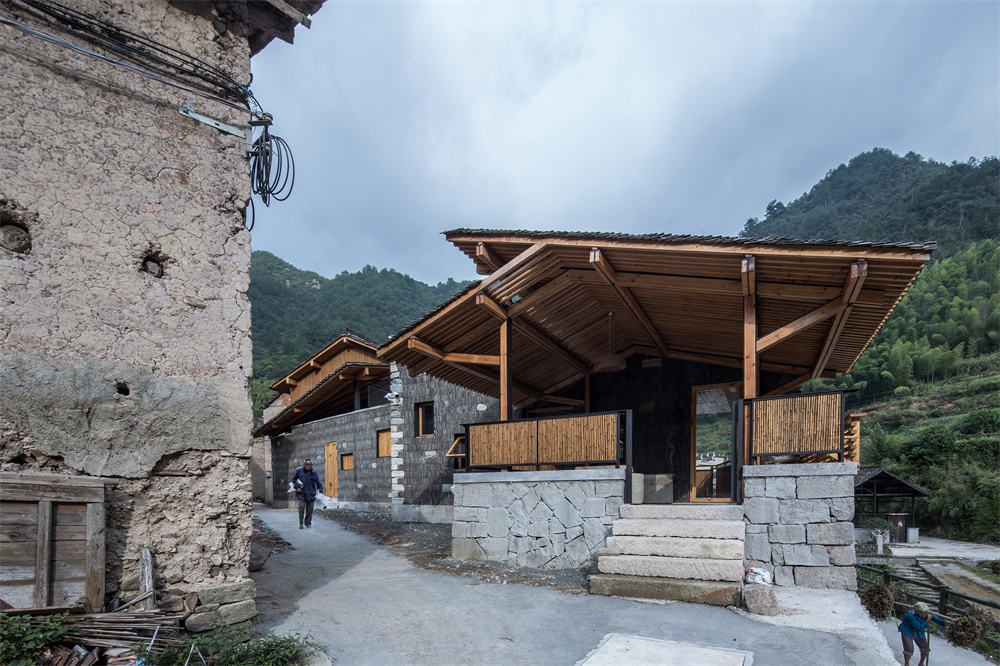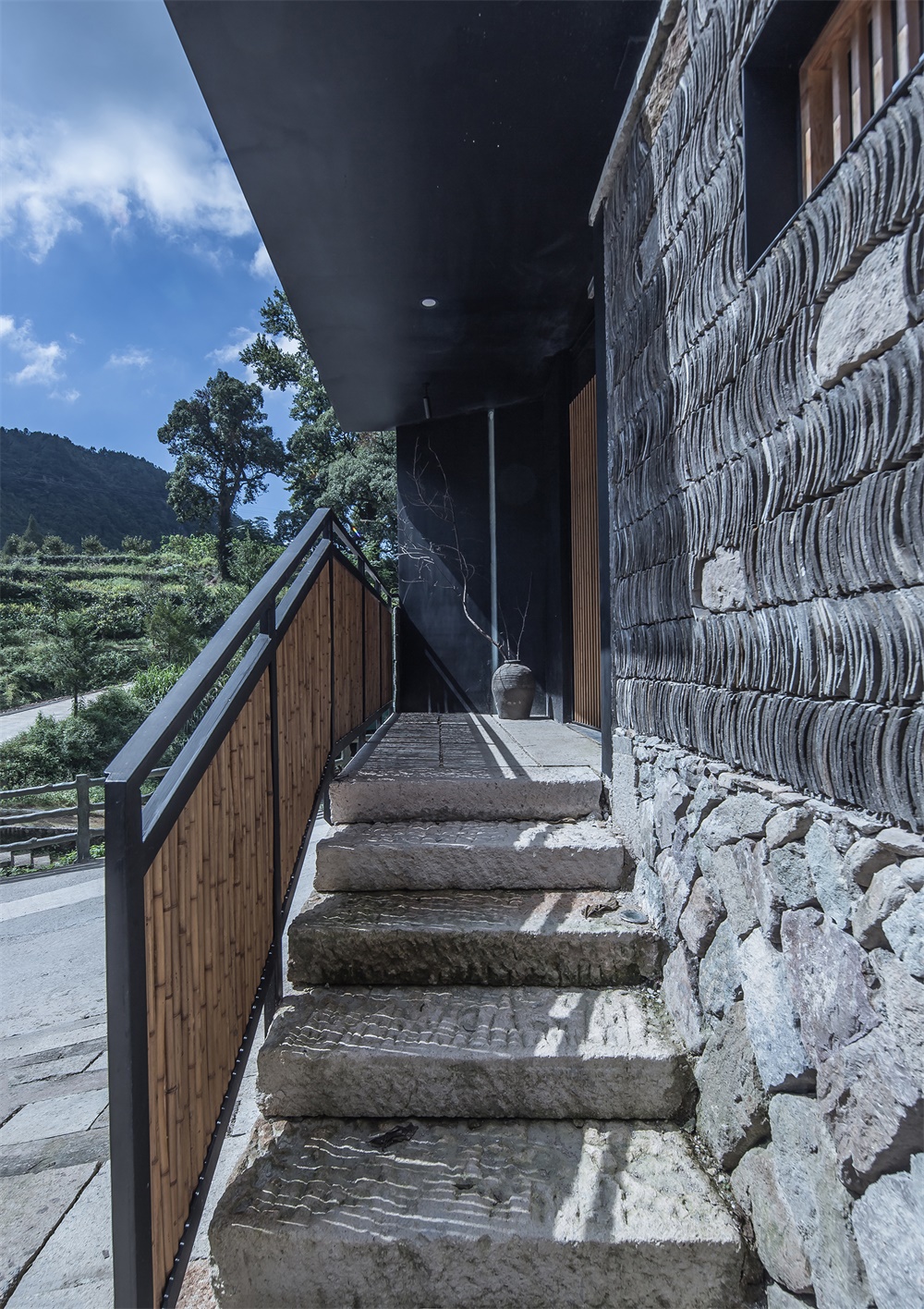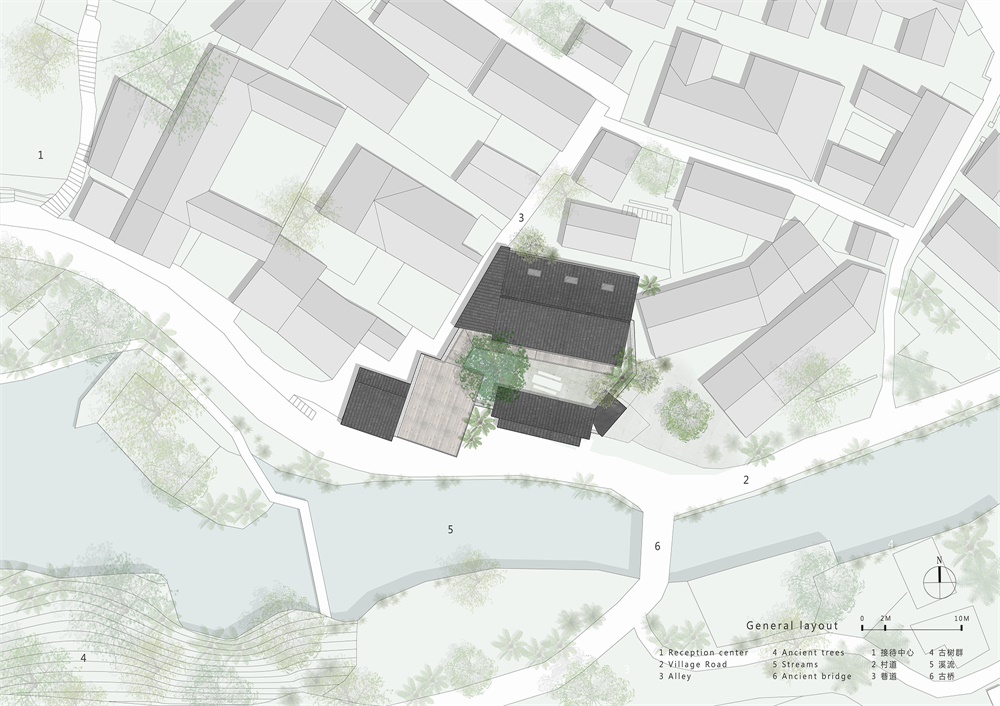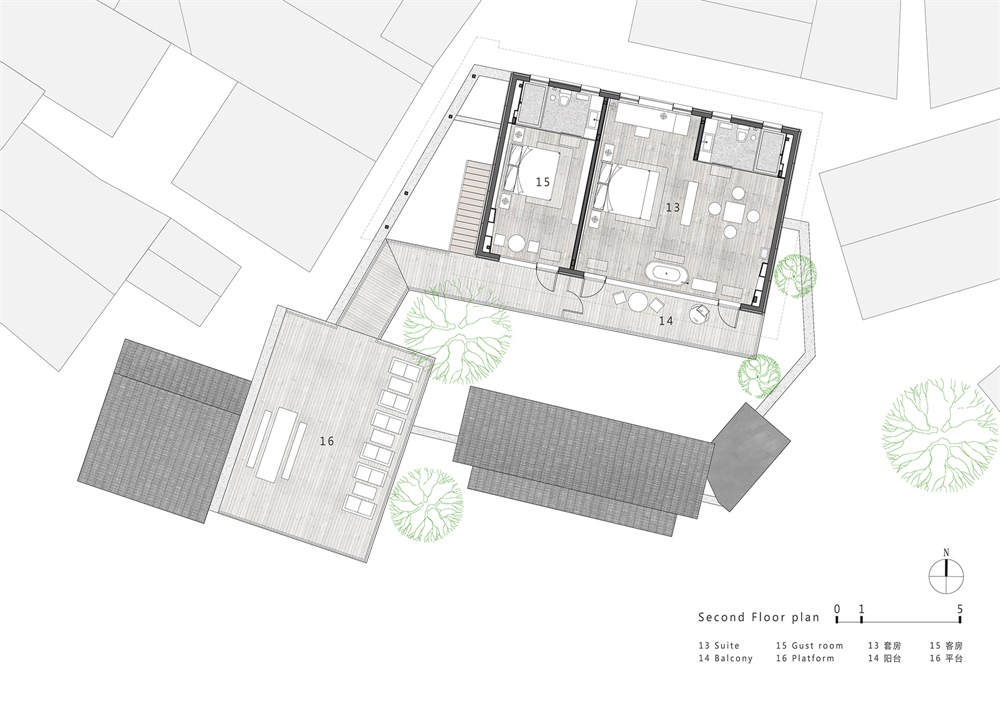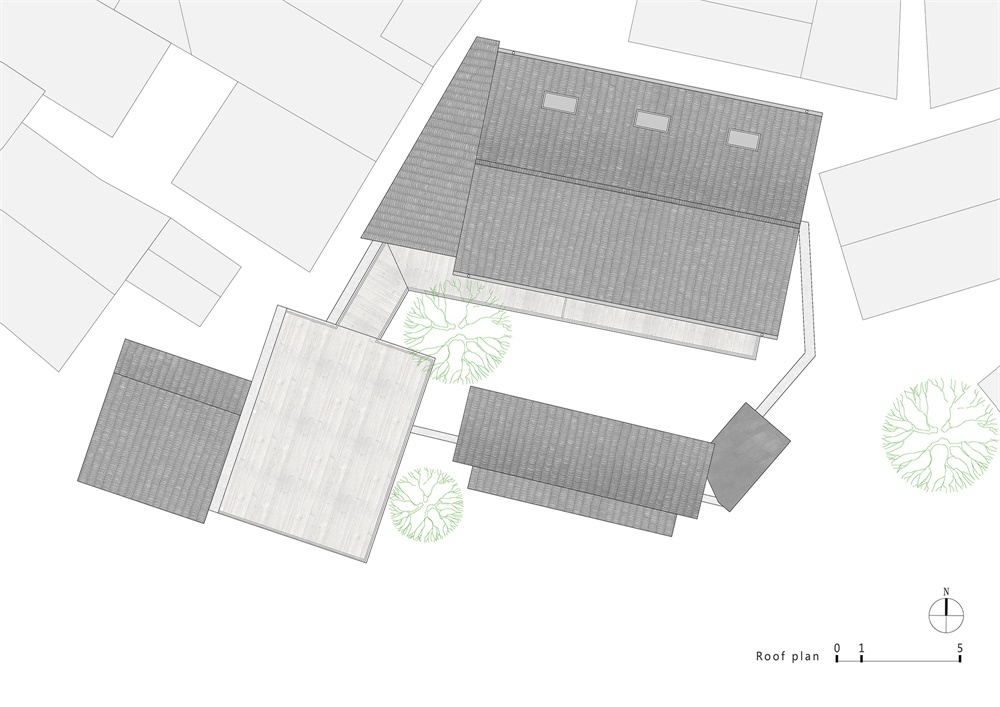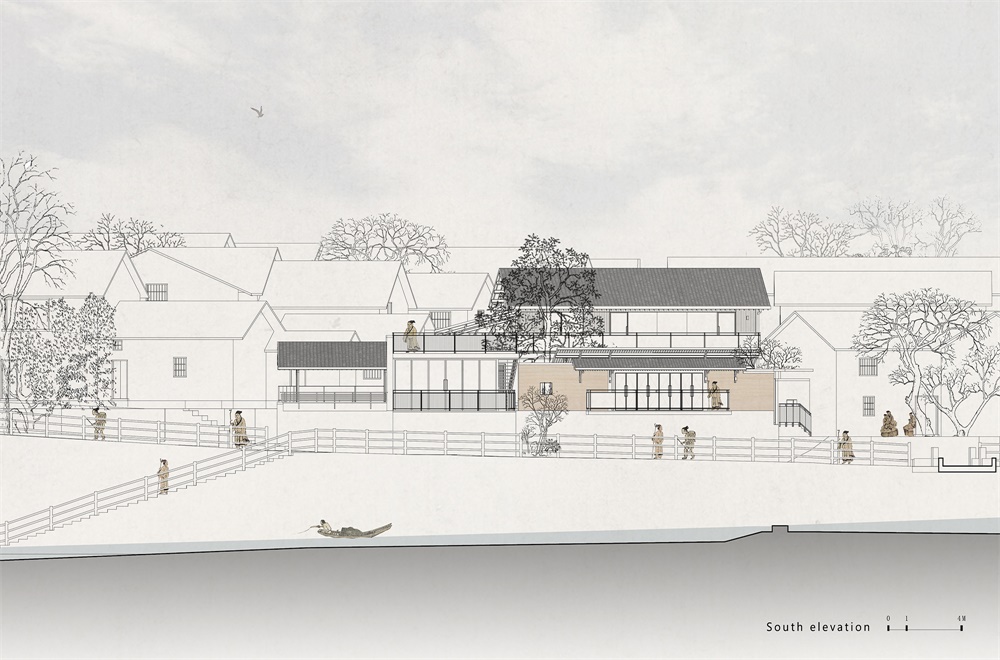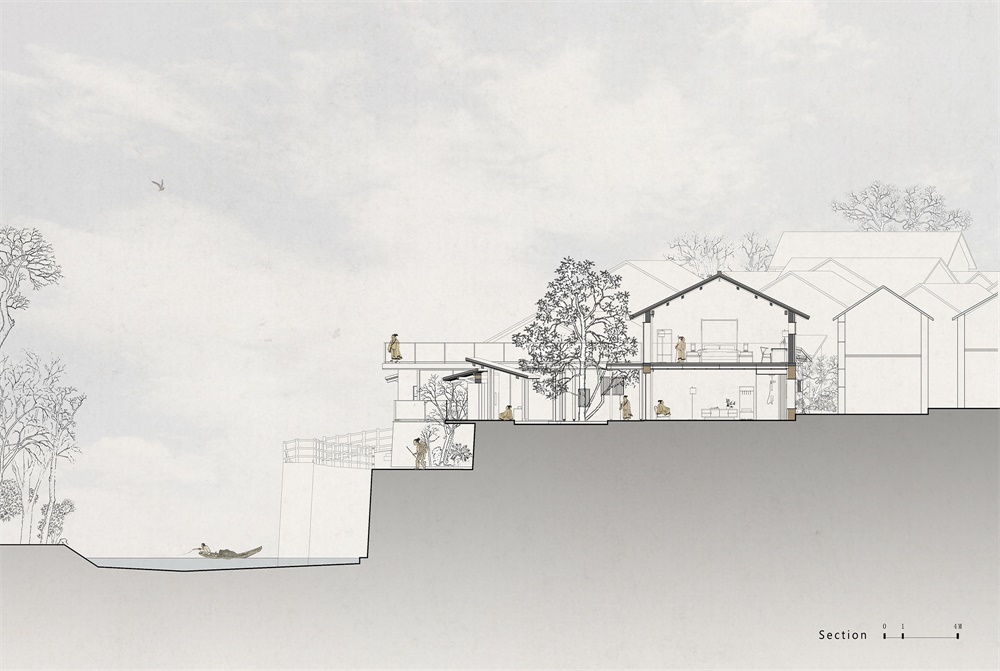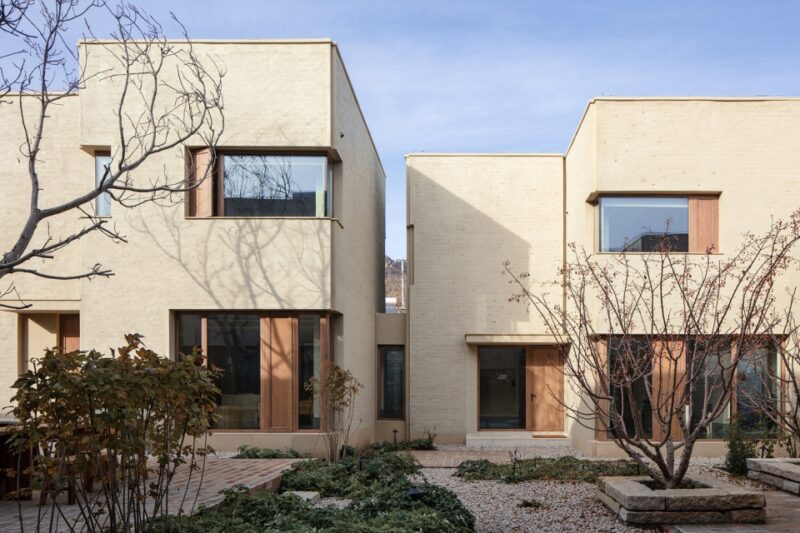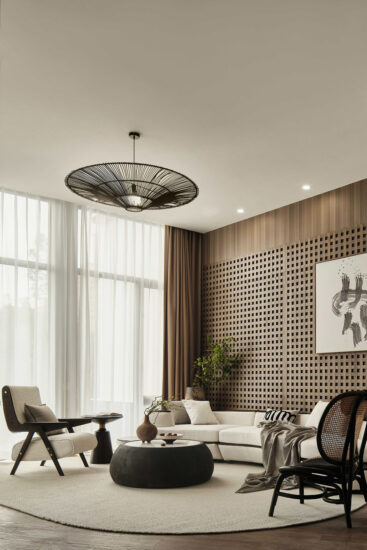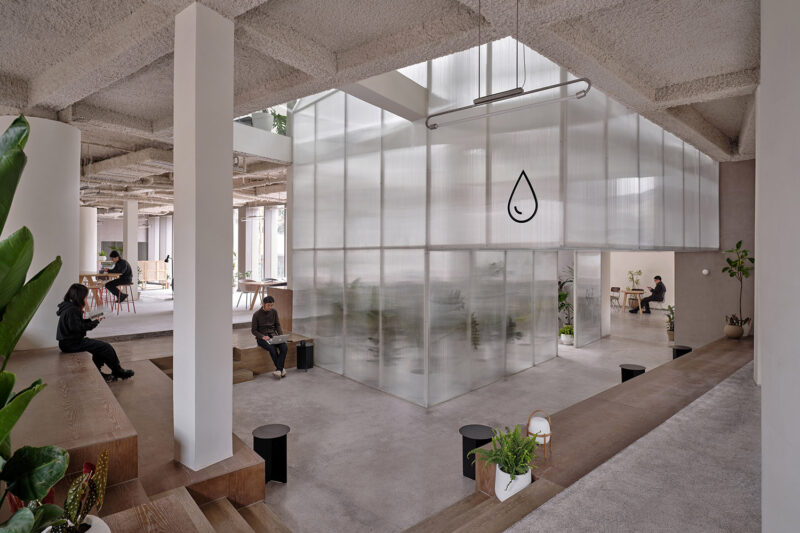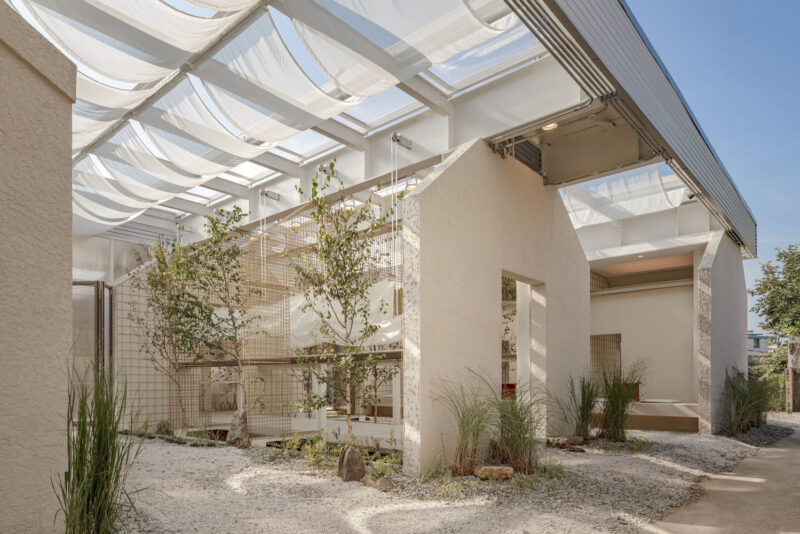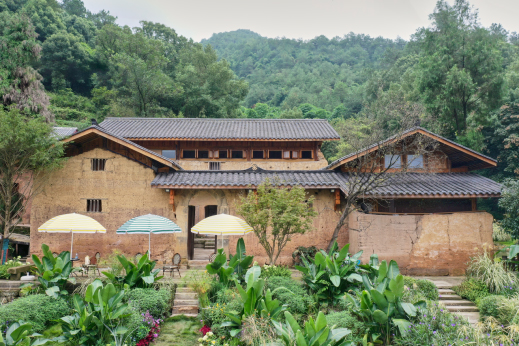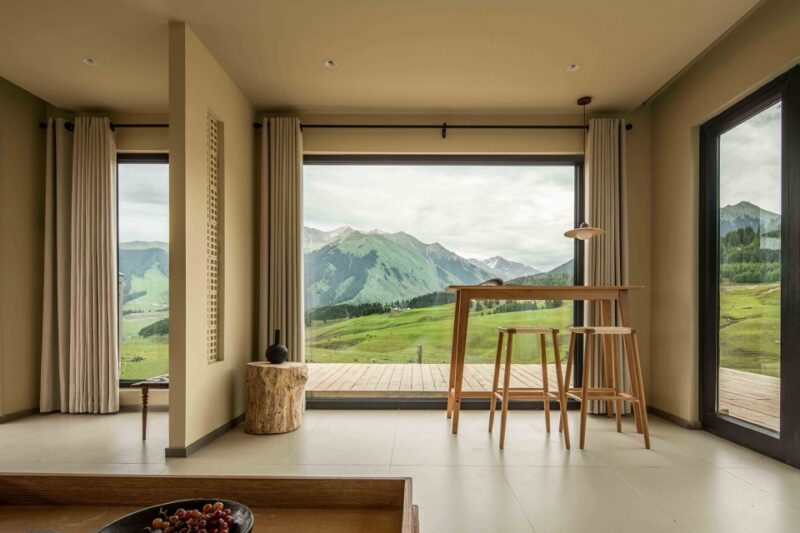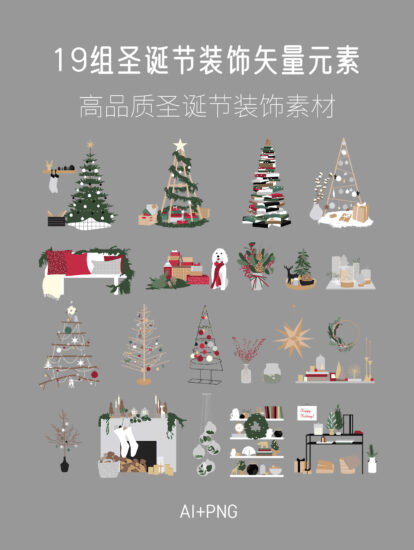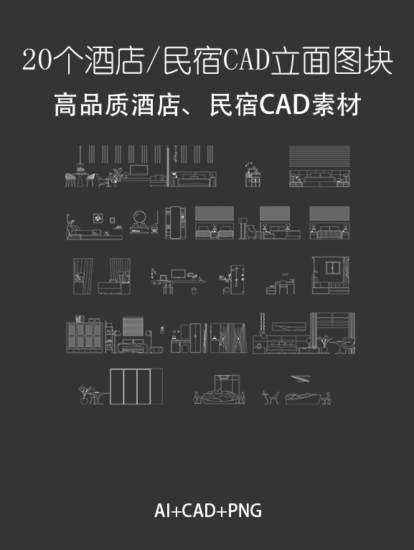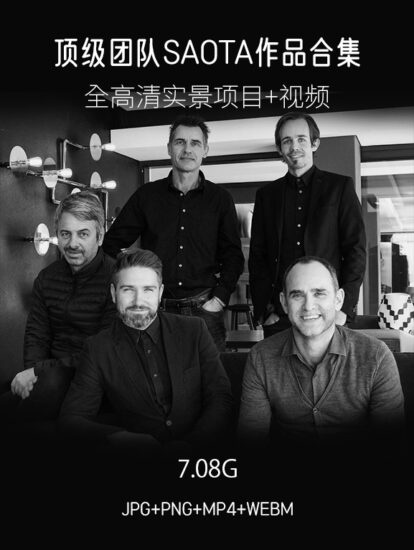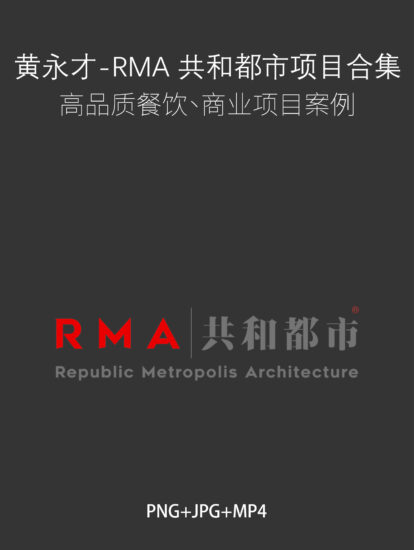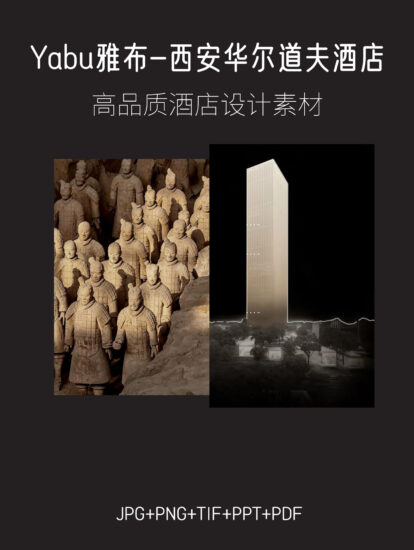全球設計風向感謝來自 尌林建築設計事務所 的民宿項目案例分享:
項目基地位於浙江省金華武義縣梁家山村,村中建築依山而建,大部分建築都是木結構夯土牆,一條小溪穿流過村落,溪邊古樹尚存。清嘯山居坐落於村莊的古樹旁小溪邊,小溪對岸就是梯田和環山,背靠整個村落和大山,是理想中的隱居之所,場地原址有一棟三開間兩層高的夯土房和一個小公廁,夯土房牆麵已經大麵積開裂,牆體傾斜外擴,綜合考慮各方麵因素決定將其拆除重建。
The project is based in Liangjiashan Village in Wuyi County, Jinhua, Zhejiang Province. Seated by the mountain, most local buildings are constructed with wood structure and rammed earth walls. The village buildings are guarded by ancient trees on the bank of a stream flowing through,. QIngxiao Residence is situated by the stream on the opposite side of the terraced fields, the distant surrounding mountains and backed by the whole village and the rolling mountain. This is an ideal retreat for seclusion. The original place had a rammed earth building with three rooms and two floors as well as a small public toilet. The rammed earth walls had cracked seriously and tilted outwards; Therefore, considering these factors, reconstruction became the most viable solution.
∇ 民宿背靠整個村落和大山Residence backed by the village and the mountains ©趙奕龍
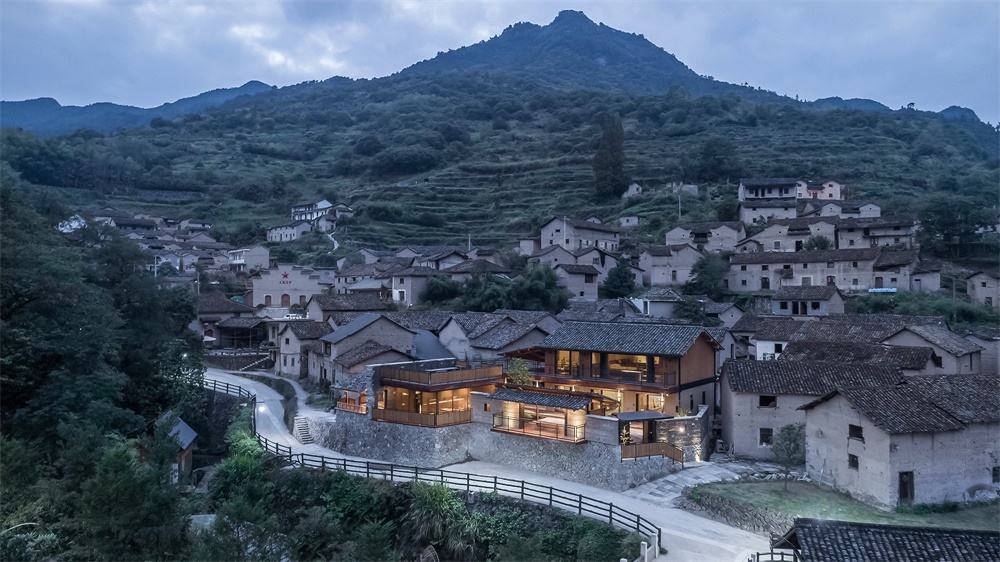
∇ 俯瞰民宿與村落的關係Overview of the residence and the village ©趙奕龍
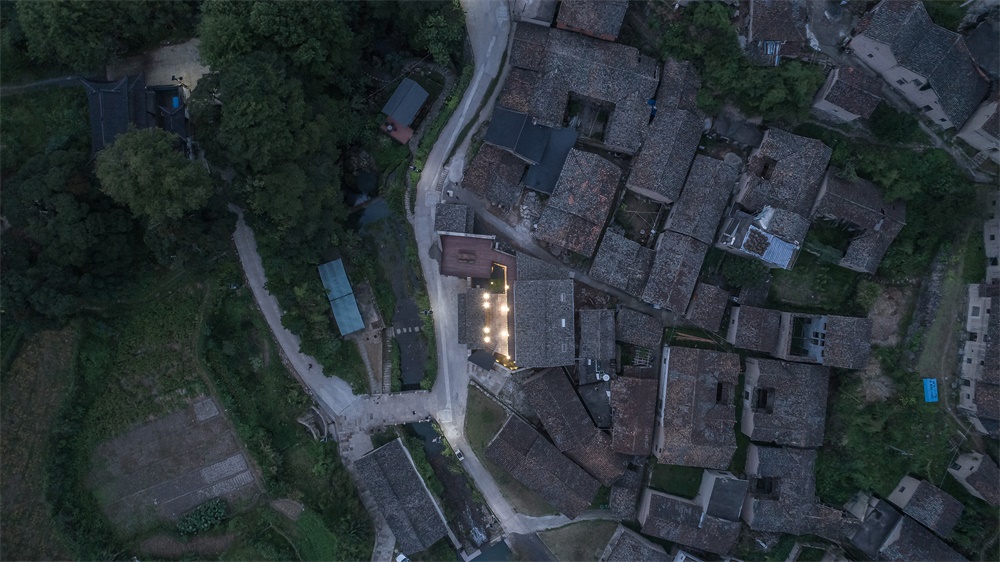
∇ 雲霧從山坳裏飄上來Clouds and mist rising from the valley ©尌林建築
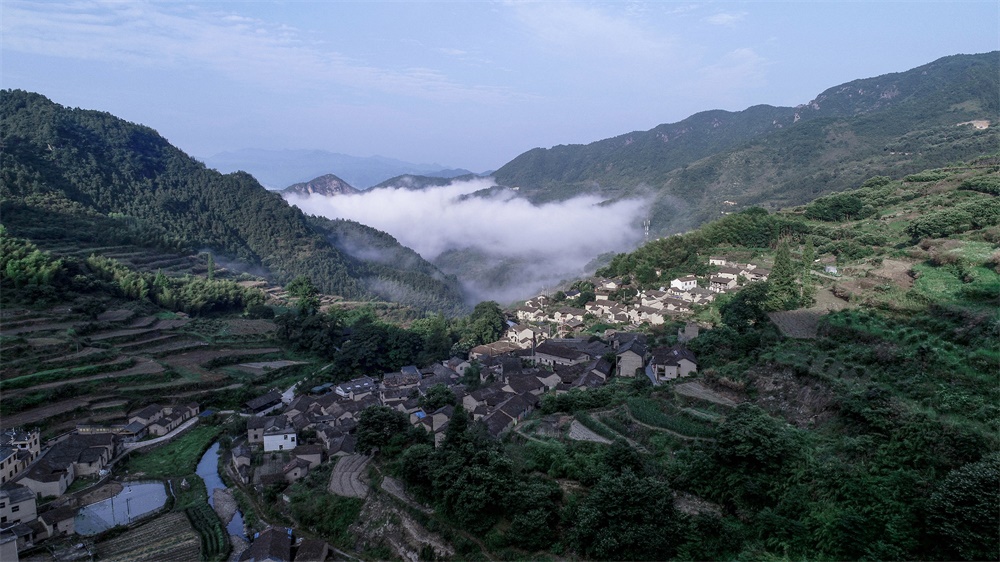
∇ 處於小溪邊的民宿融於村落中Residence integrated into the village ©趙奕龍
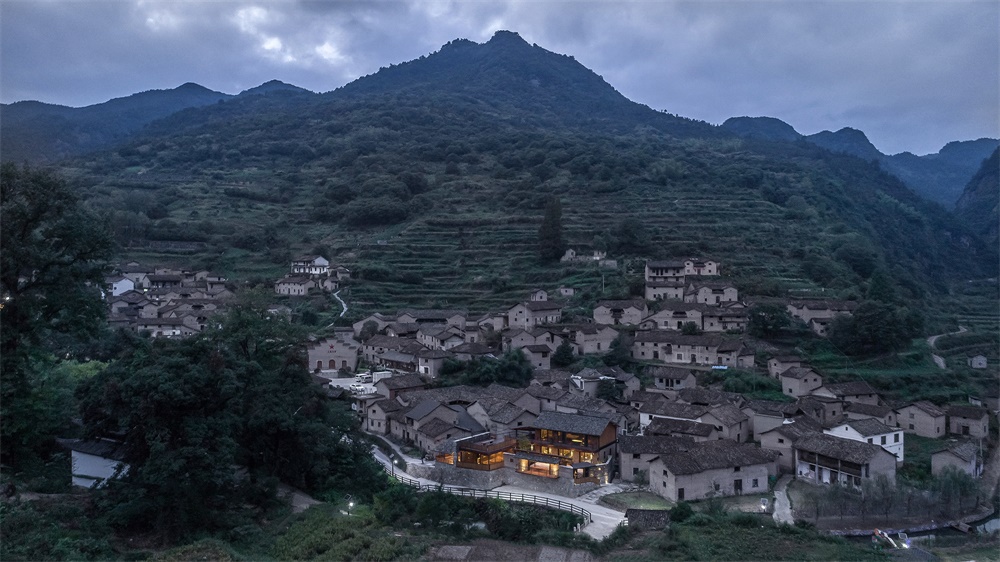
勾連場地關係
Filed relations
場地上的原建築體塊分布呈圍合狀,一棟三開間的夯土主房,旁邊分布三個小輔房,還有一個公廁,都落在一個兩米高左右的石坎台基上,與旁邊的道路小溪呈階梯狀關係,邊界呈鋸齒狀,場地原建築主房入口在建築的背麵,由北麵一條小弄堂進入。
The original building, the rammed earth house with three rooms had three small auxiliary rooms next to it, and a public toilet, all fall on a stone pedestal about two meters high. The stream nearby forms a stair with the building, whose border is jagged. The entrance of the main building on the site is on the back linked by a small alley to the north.
∇ 依山而建的村落Village built by the mountain ©尌林建築
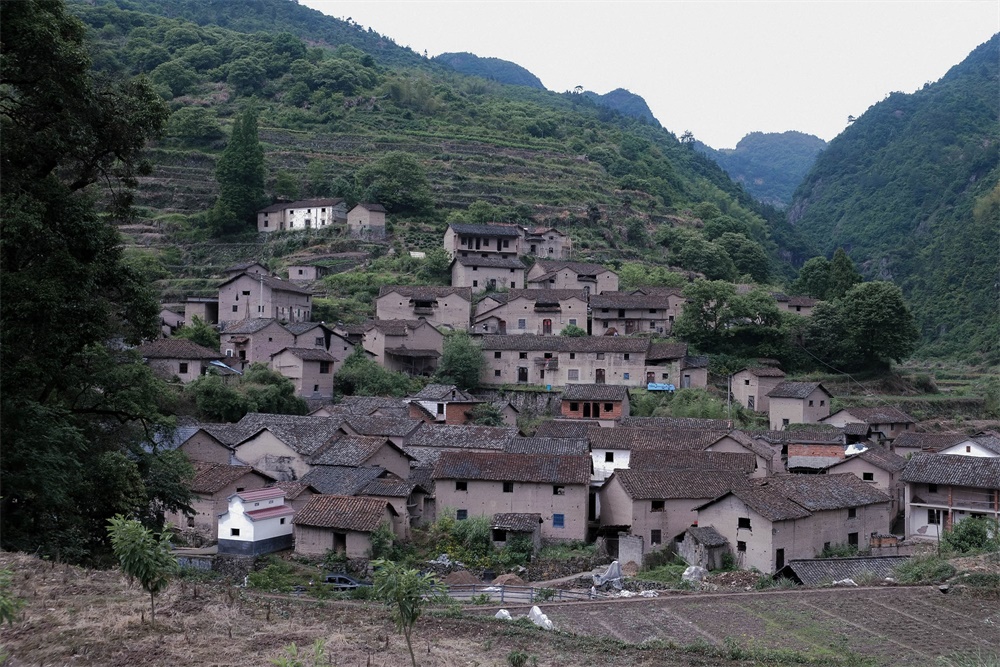
站在場地對麵的山坡上,能看到整個村子的全貌,項目場地位於河邊最顯眼的地方,在這個位置做一個民宿,應該要完全融入原村落的整體肌理和空間組織關係中。在建築方案中延續建築體塊的內向型組織關係,保持原有組團的體塊軸線關係,重新梳理建築邊界,延續和強化建築在台基上的基地關係,重新組織村落肌理、組團空間、建築形態、台基、巷道、小溪、梯田、環山之間的勾連關係。
Standing on the hillside opposite of the building, the entire village comes into sight. The project is located at the most conspicuous place by the river. A residence here should be fully integrated into the overall texture and spatial organization of the original village. The architectural design retains the inward-looking organization of the building, maintaining the original mass axis relationship, reorganizing the building boundary, continuing and strengthening the base of the building on the platform, and re-structuring the texture, group space, architecture and the relationship between the base, alleys, the stream, the terraced fields and the surrounding mountains.
∇ 東南角建築外景Exterior view from the southeast ©趙奕龍
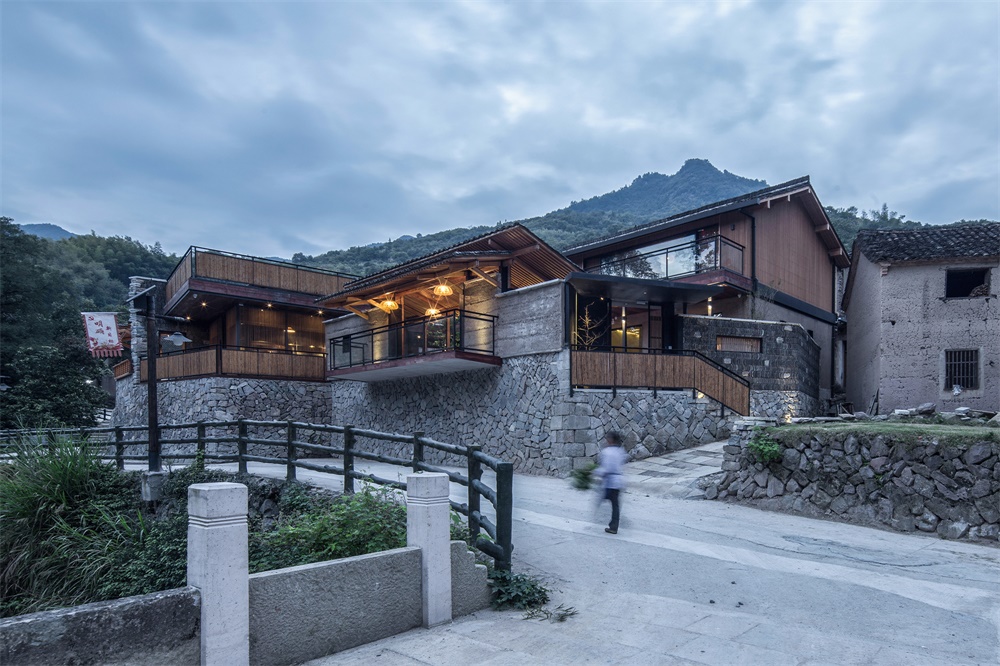
∇ 從溪對岸看建築正麵Residence from across the creek ©趙奕龍

∇ 軸測圖Axonometric picture ©尌林建築
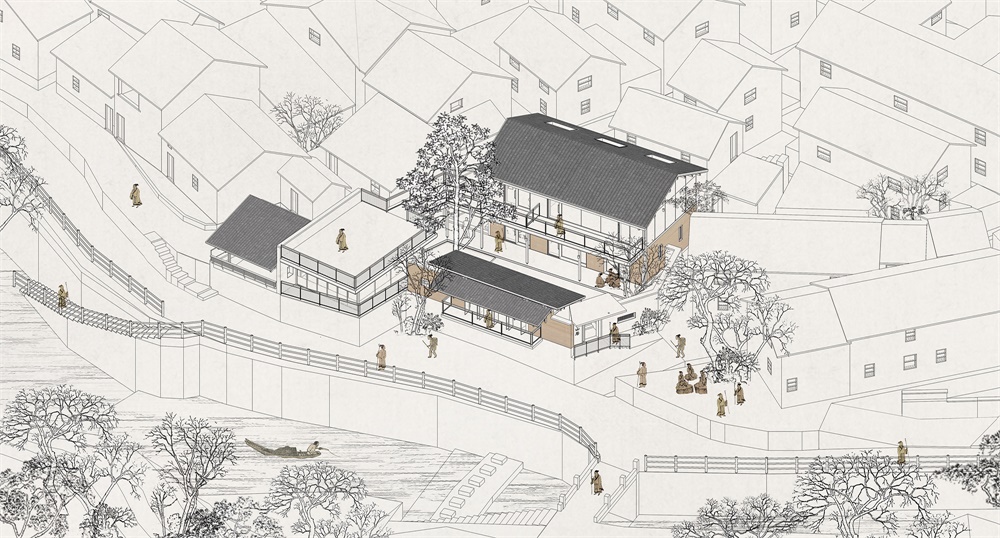
∇ 方案推演過程Scheme deduction process ©尌林建築
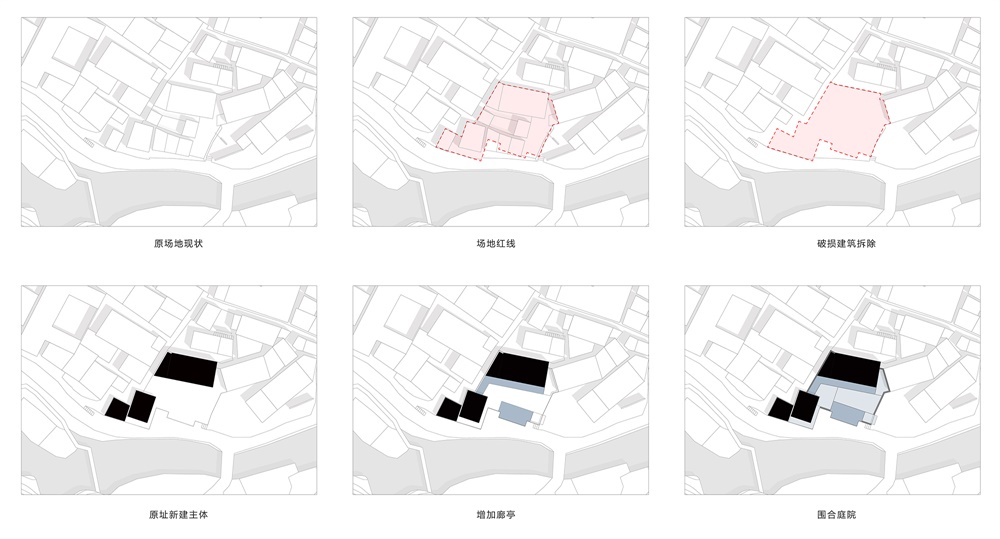
鄉村在地性
Local Village
在村落中行走,隨著地形的高低變化,民居的體量大小變化,方向的偏轉,屋頂的邊界關係呈現出來一種錯落有致,變化無窮的狀態。這種狀態希望在設計中呈現出來,以呼應當地建築屋頂形態的變化關係,所以建築的體量被打散分解重構,屋頂方向斜度變化,形成與原有村落民居和諧的屋簷關係和體量關係。
With the changes in terrain altitude, dwelling volume and direction, the boundaries of the roof also present an ever-changing relationship, which is hoped to be presented in the architecture to echo the variation in local roofs. The whole building was broken down and re-structured to demonstrate changes in directions and slopes of the roof so that the roof itself and the volume form a harmonious relationship with the local village.
村子房屋基本都是依山而建,而且多為夯土房,怕潮濕和水,自然形成很多階梯狀台地,房屋都造在一個個石砌台地上。基地處原建築也是建造在一個石砌台地之上,台基下方是一條沿溪村道,溪流與村道又有比較大的高差,所以場地處就形成了多層級、高差大的階梯狀台地關係。建築的主入口設置從下麵村道處進入,便出現了入口處的三次轉折來消化地形的高差關係,一段為石板鋪設的坡道,上坡道後一條路經順勢通往鄰家,一條折回,幾個石條踏步進入建築入口處,進門後,轉向又行幾個踏步進入庭院,入口處有一種婉轉上山的體驗,也是台地高差所帶來的路徑變化,這種體驗也延續了在古村中的行走體驗。
Village houses are basically built by the mountain, most of which are made of rammed earth that is sensitive to humidity and water, and naturally forms a terraced landscape. The original building at the base was built on a stone platform, below which a stream runs through, posing a relatively big difference in altitude with the path, and therefore forming a multi-level, stair-like platform with the location. The main entrance is set from the village path below, and there are three turns at the entrance to mitigate the height difference of the terrain. A stone slope leads the way towards the neighborhood, where a twist introduces several stone stairs to the entrance. Turing around for several steps, the path continues to the courtyard, providing an experience of climbing up the mountain by changes in height, which also reflects on a walking experience in the old village.
∇ 建築落在石頭台基上Residence falls on a stone platform ©趙奕龍
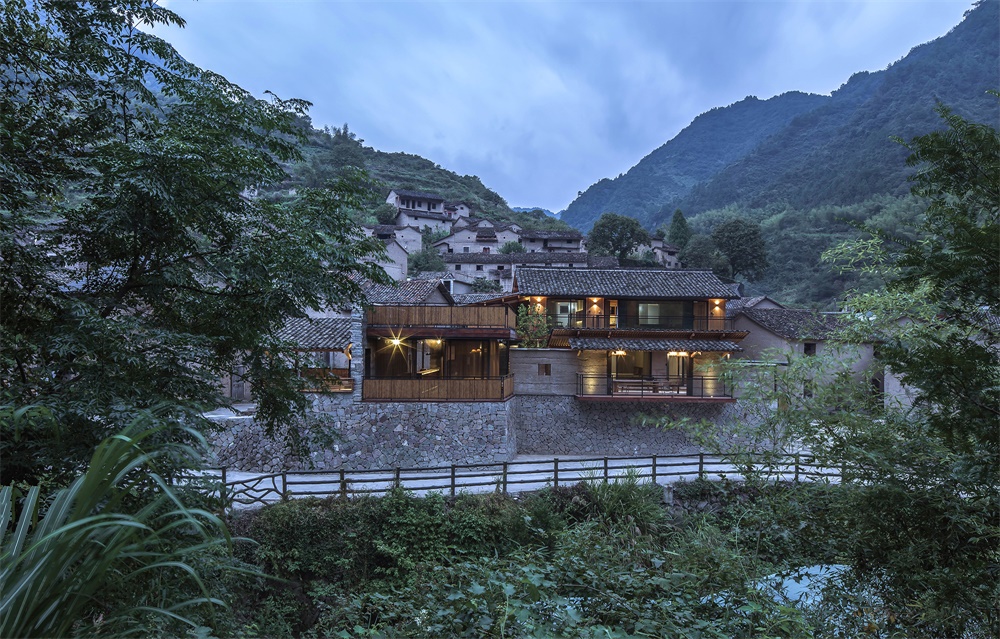
∇ 鋸齒狀的建築形態與村道的關係Jagged building and village paths ©趙奕龍
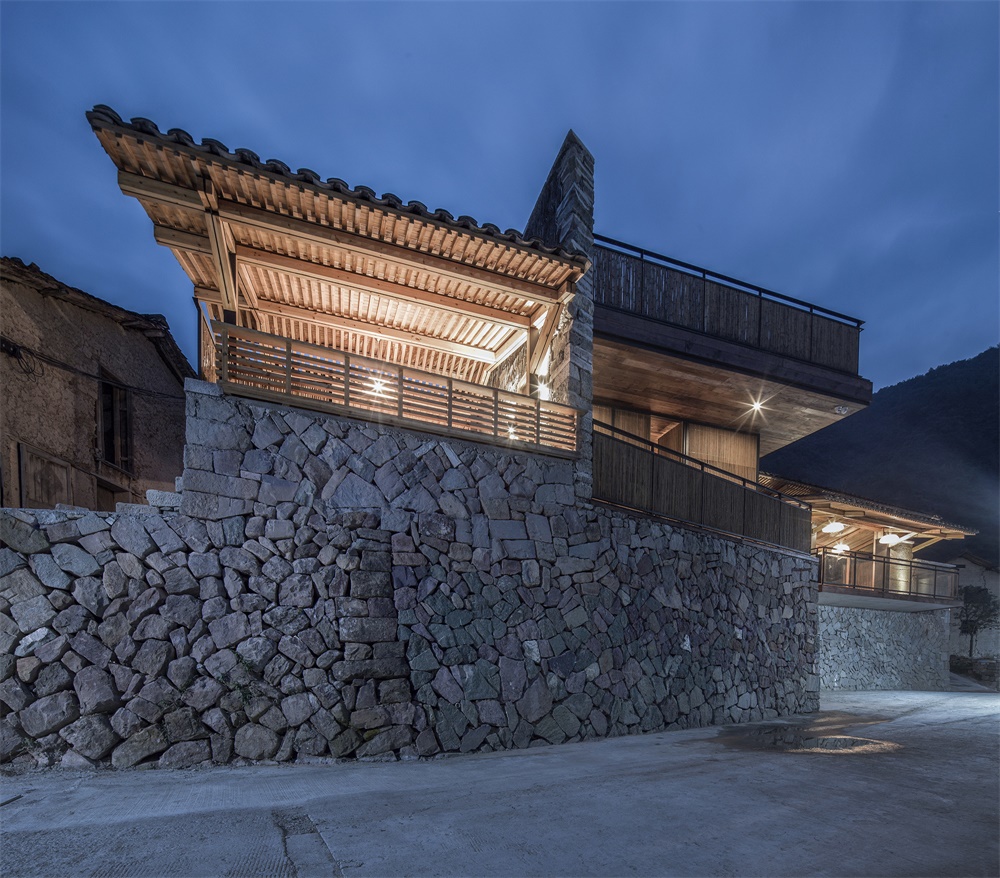
∇ 建築東麵入口夜景Night view of the east entrance ©趙奕龍
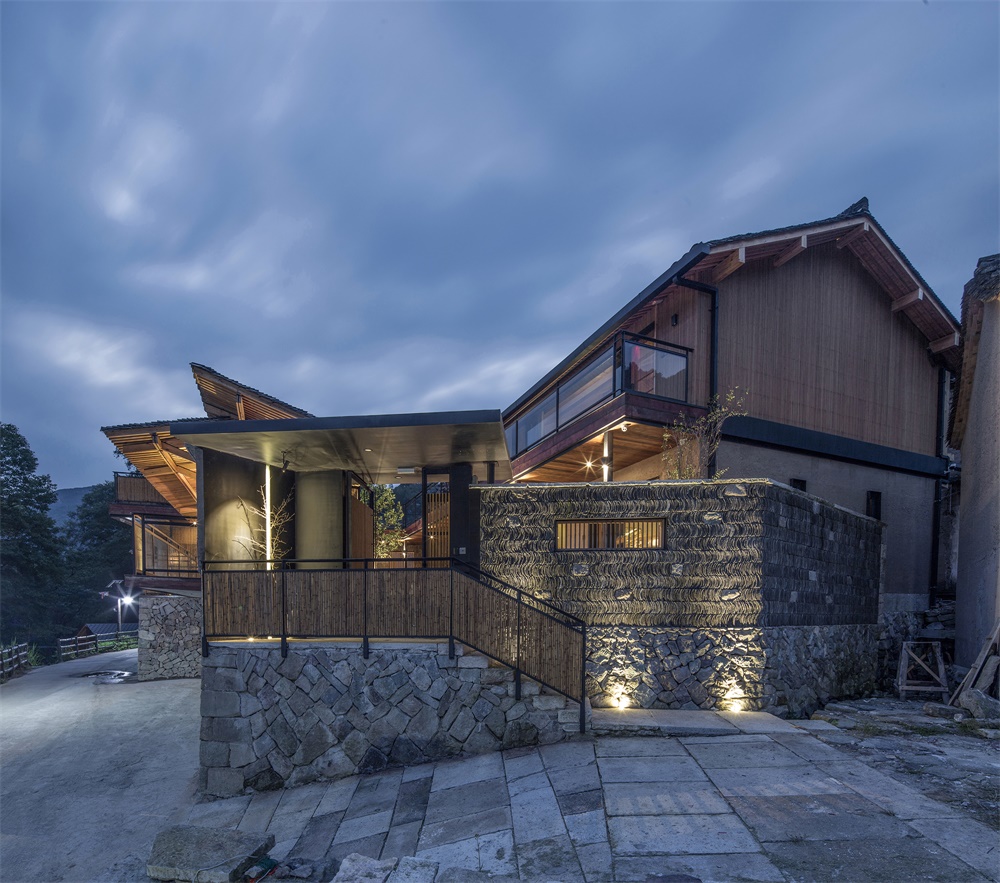
鄉村營造存在特有的限製性因素,交通不便,資源匱乏,在建築材料運用上,利用在地化的材料變成一種建造策略,村落中回收的小青瓦、原建築夯土牆體材料、當地的毛石砌塊、竹子、老石板、回收老木板,水磨石,都是一些在地化的材料,方便就地取材,回收利用,再生環保。
Rural construction has unique restrictive factors like inconvenient transportation, and lack of resources. So, building materials are highly localized, using green tiles recovered in the village, the original building’s materials are recycled; including, rammed earth wall materials, local masonry blocks, bamboo, old stone slabs, recycled old rubbles, and terrazzo, which are convenient for local material retrieval, recycling, and are environmental-friendly.
∇ 現場建造場景Construction on the site ©尌林建築
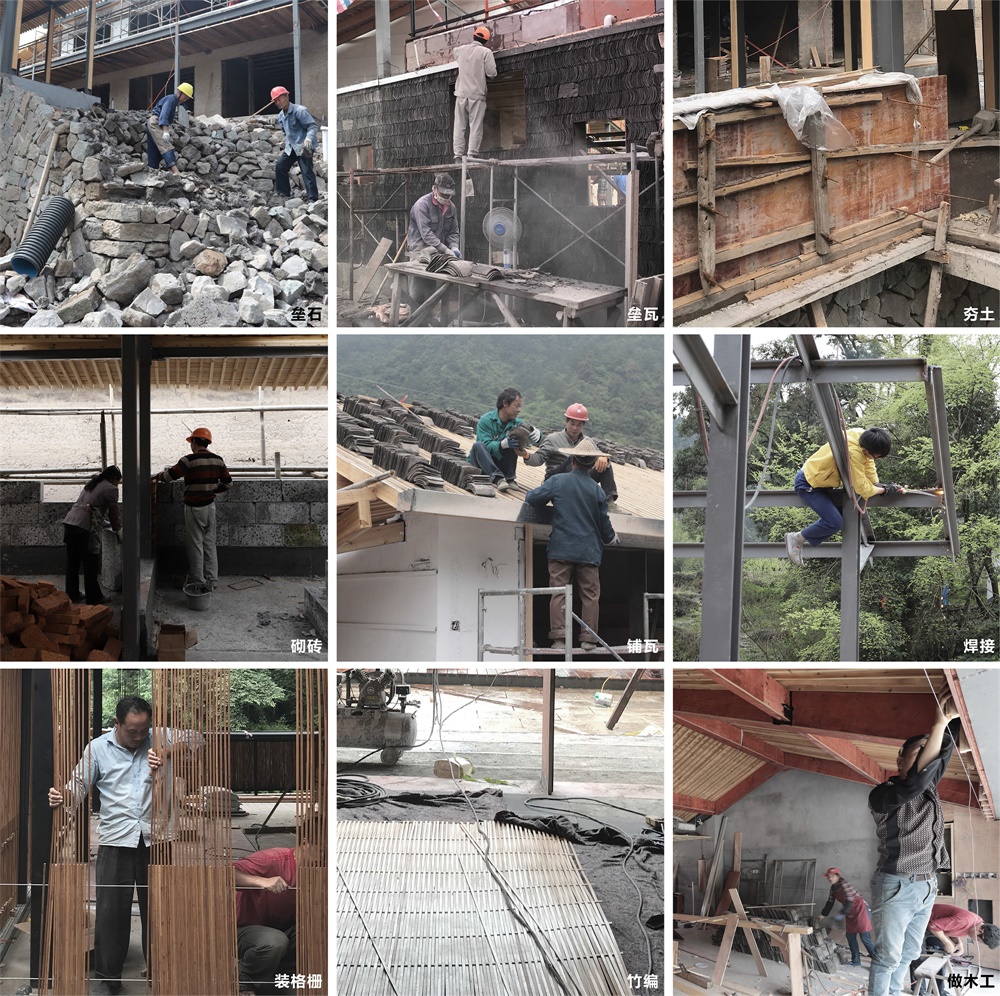
在建造工法上,遵循當地的的一些傳統建造工藝,建築主體的牆體材料回收利用原夯土房上拆除下來的土料,拆除後堆放在建築旁邊空地,民宿建造時將其重新夯築作為牆體,一方麵節約材料的采購和運輸成本,一方麵夯土材料可回收再利用的特性被充分體現。延續鄉村記憶和建造工法,是對鄉村匠人智慧的尊重和傳統建造技藝的傳承,也是提倡一種再生循環和在地化的鄉村營造理念。
The construction method follows local traditional construction techniques by recycling the main materials from the original walls of the rammed earth house. After removal, they are piled on the ground beside the building. During construction, they were used as the new wall after disposal. For one thing, this saves costs for purchasing and transporting materials; for another, functions of rammed materials were also given full play. It’s an extension of memory and construing method of the countryside, but also an inheritance of traditional technique and respect towards the wisdom of craftsmen in the village. It also advocates for a mindset of recycling in the local village.
∇ 建築西側與巷道的鋸齒狀體量關係West side of the residence and the jagged path ©趙奕龍
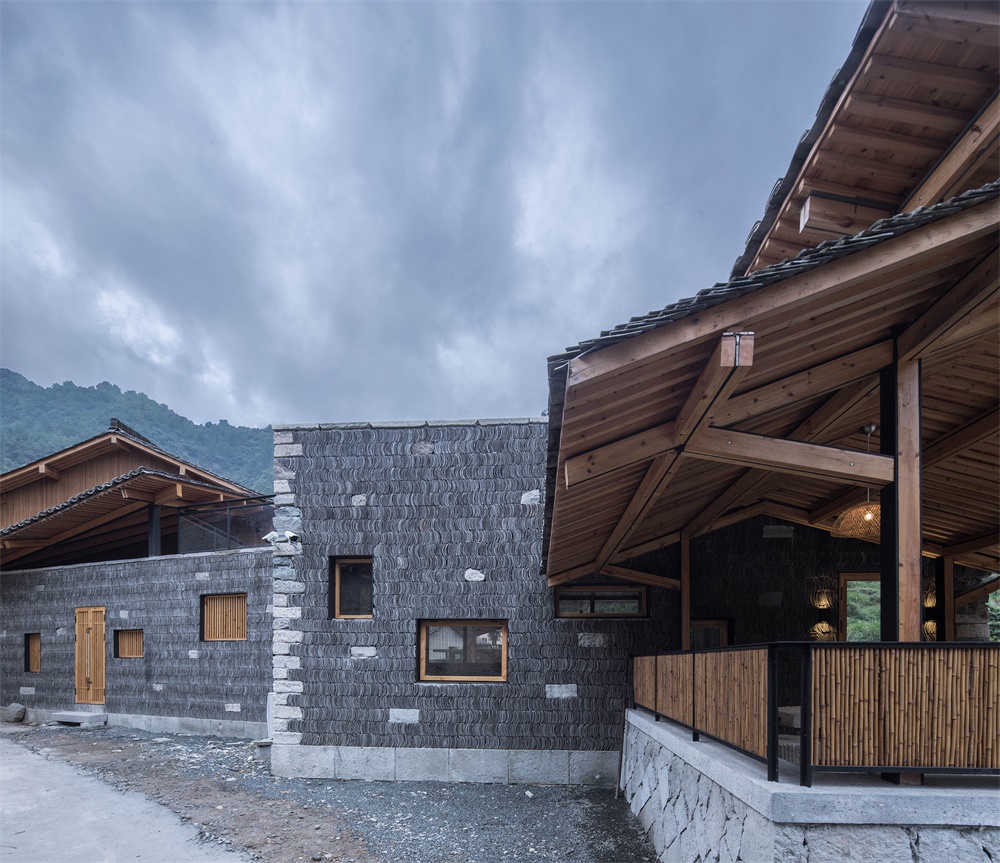
∇ 小青瓦壘砌牆體與亭子的關係Grey tile wall and the pavilion ©尌林建築
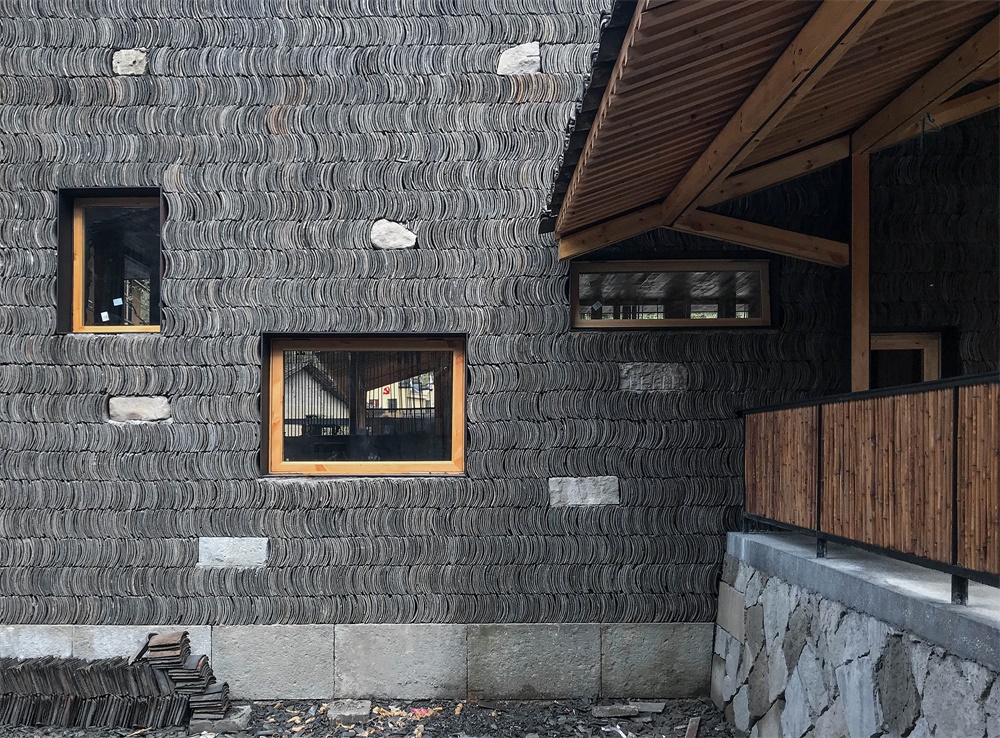
∇ 樓梯處空間與廊道庭院的轉折關係The transition between the stairs and the corridor courtyard ©尌林建築
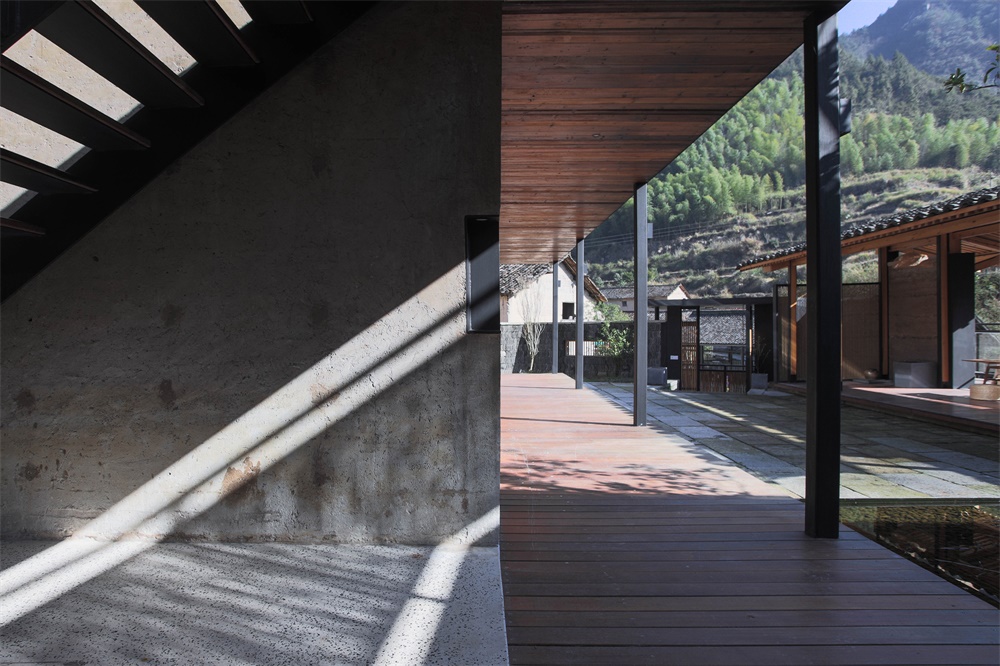
∇ 傳統民居夯土轉角保護研究 Corner protection of rammed earth in the residence ©尌林建築
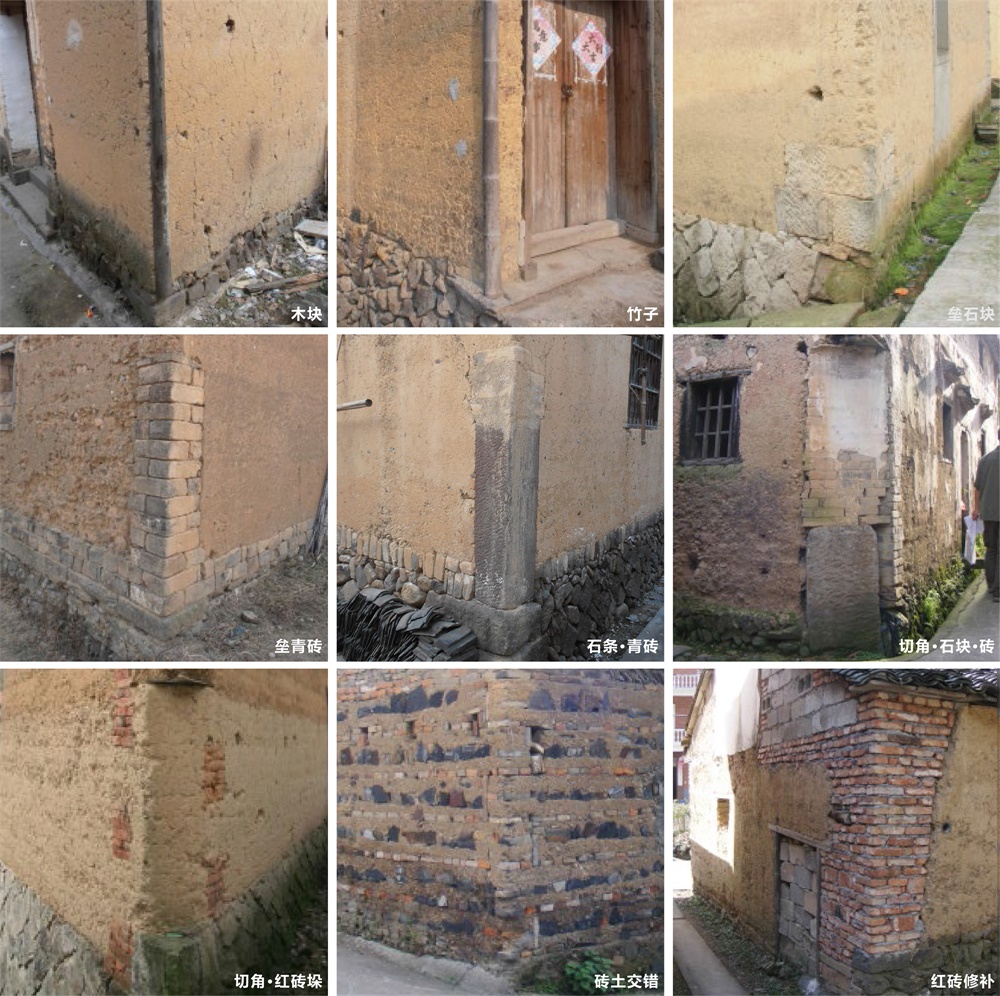
∇ 夯土轉角處設計細節 Design details at the corner of rammed earth ©尌林建築
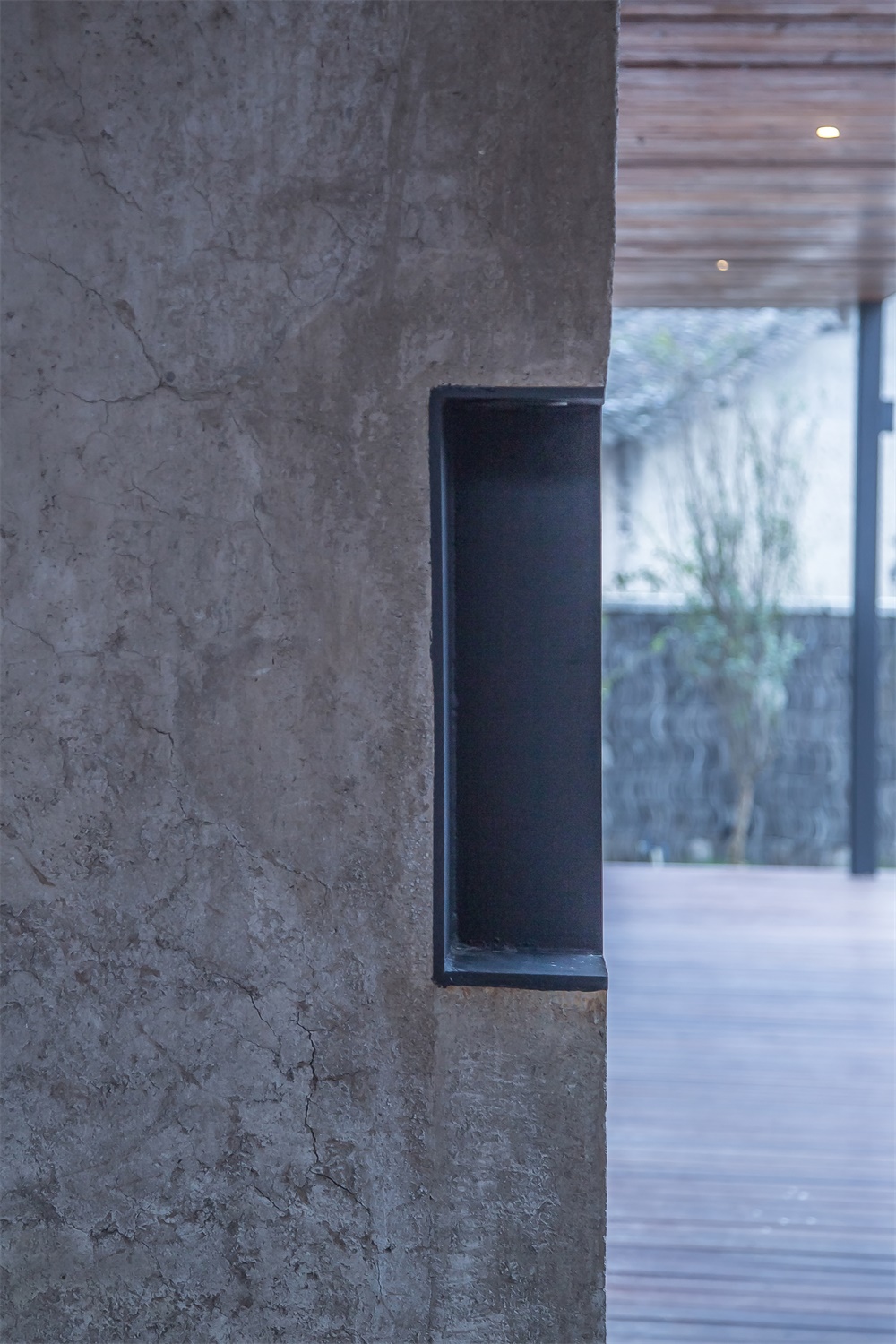
建造的過程中,我們要求用當地的匠人參與建造,幹一天活給一天錢,他們會用匠人精神把活幹好,每天做多少算多少,做完工地的活就回家幹農活了,不指望著賺多少錢,這樣才能把活幹好。看鄉村匠人幹活能感受到什麼是真實建造,砌石頭牆每塊石頭都要挑過,順應其形態擇其位置,下大上小,自下而上,真實的受力關係和建造邏輯,同時保留手工建造的痕跡和時間的印記,強調建造的真實性。
During construction, we asked local artisans to participate and provided due payment every day. Wage is paid according to their daily work, and they usually finish their work before going back home for farming without much expectation to get a high salary from long-term work. We think this brings the best quality in their working. The artisans can sense the internal structure by selecting each brick to build up the wall in a suitable position. Bigger ones are put at the bottom while smaller ones at the top. Construction in this way follows the law of force and natural principles. At the same time, hand-made traces and imprints of time are kept for originality.
建築結構用的是施工比較方便的鋼木結構,其結構邏輯與村落中傳統建築的構成邏輯相似,結構與外圍護牆體體係脫開,用連接點將結構與外牆體連接。
The building uses a more convenient steel and wood structure. Similar to the idea of a traditional building in the village, the structure is separated from the outer wall system, and connected to the external wall with connection points.
∇ 建造過程 Construction process ©尌林建築
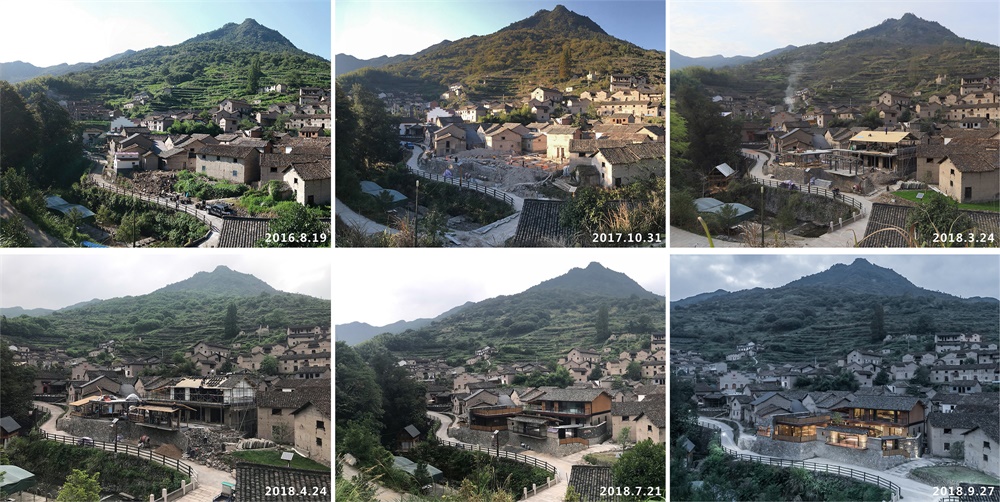
如何將自然引入建築中
How to bring nature into architecture
站在場地中,映入眼簾的便是溪對岸的梯田古樹和環山,將自然景觀引入建築空間中變成一個重要元素,民宿所有的客房大開窗麵都麵對梯田和山景,最大限度的把山景映入室內空間。望山亭是專門為了看山而設置的喝茶休閑空間,穿插在內庭院和小溪之間,故意將屋簷口壓的很低,站在內院視線是被屋簷高度控製往下看梯田和小溪,當你靜坐在亭下便環山入目。
Standing in the field, the terraced trees and mountains around the river come into sight. The introduction of natural landscape has become an important element in the project. As the guest rooms have large windows facing the terraced landscape and distant mountains. It introduces the view into the interior space as much as possible. Wangshan Pavilion is a leisure place for a cup of tea or simple rest. The roof is designed very low to focus the view on the inner courtyard and the stream, so that guests will embrace the sight of surrounding mountains upon sitting down.
∇ 觀山亭連接內庭院與外部景觀Guanshan Pavilion connects the inner courtyard with the outer landscape ©趙奕龍
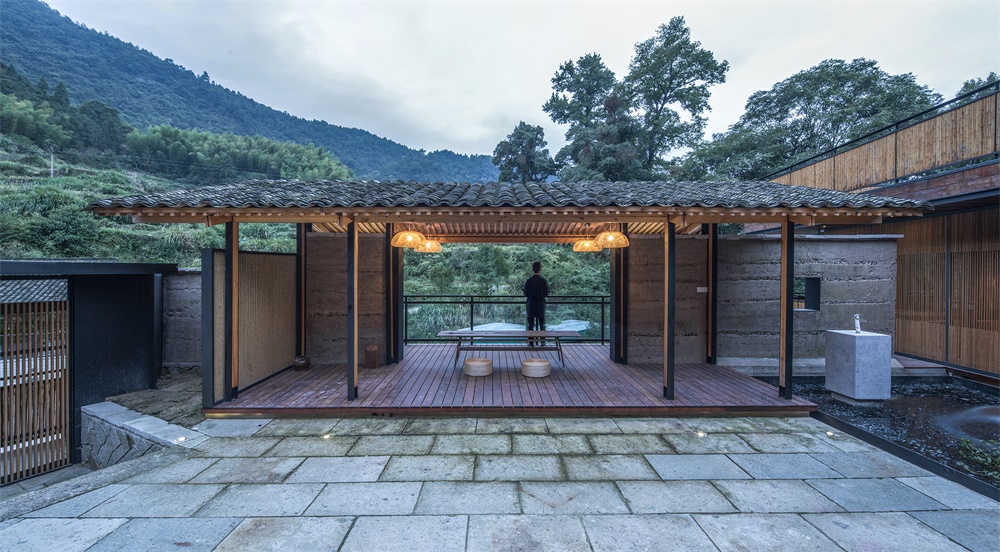
∇ 觀山亭與內庭院場景Guanshan Pavilion and the inner courtyard ©趙奕龍
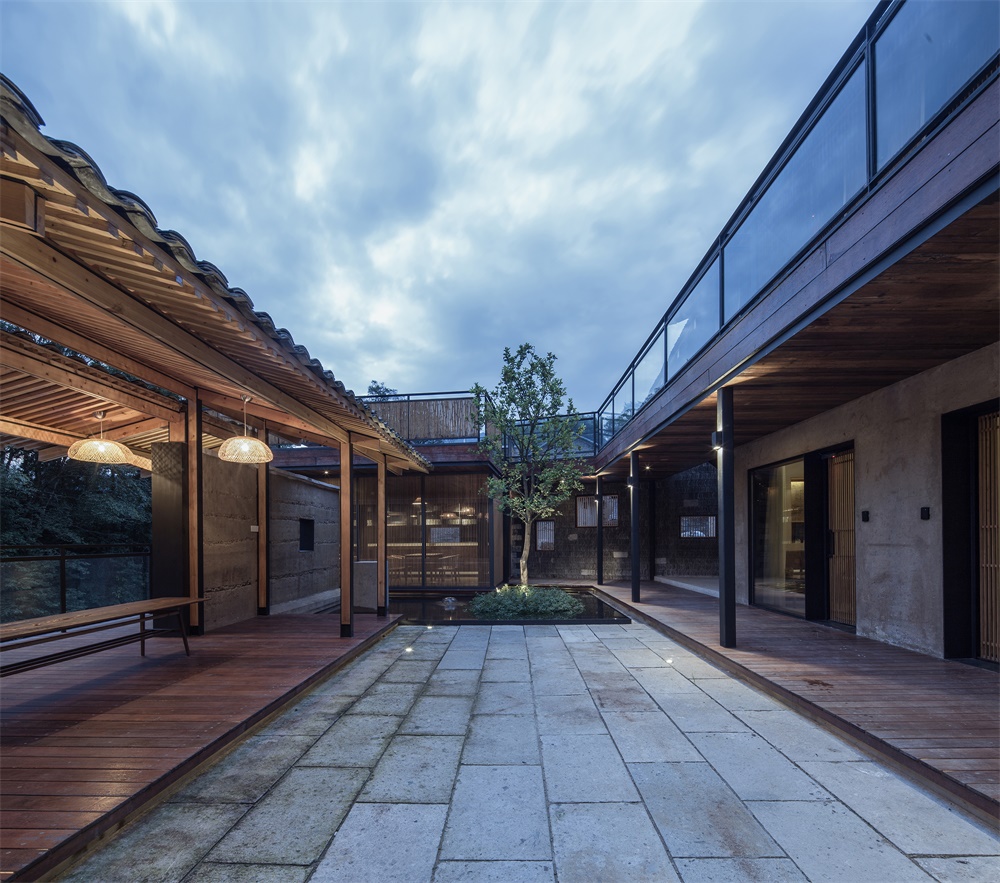
∇ 觀山亭局部場景Details of Guanshan Pavilion ©趙奕龍
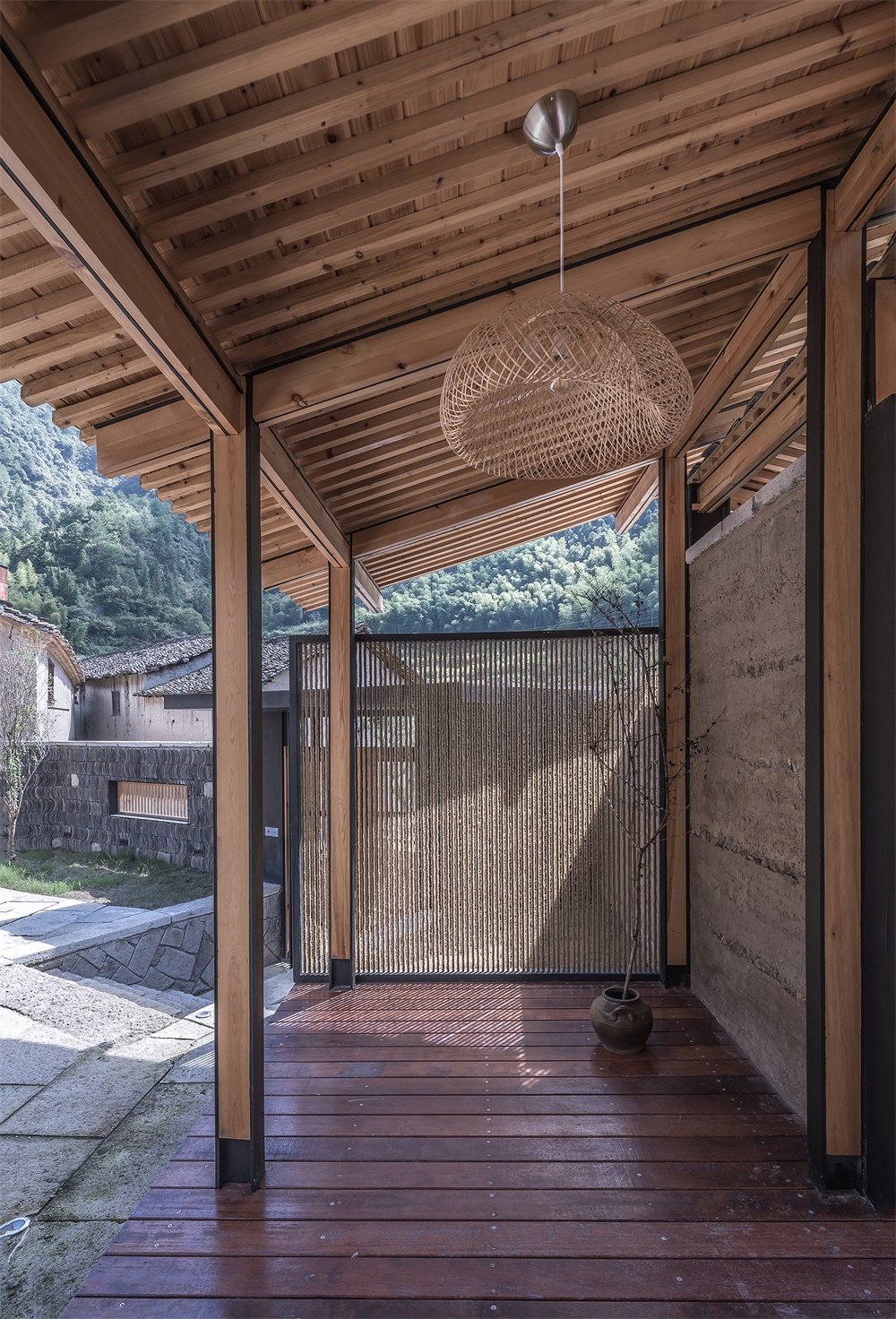
水吧作為民宿裏麵的公共空間,可以對外開放,是一個比較扁平的空間,外立麵用竹格柵疏密布置,分上中下三段,水吧三個界麵的視線明暗形成橫向連續的畫麵關係,類似一張古畫卷軸,古樹在橫向的卷軸中變成了畫的一部分,卷軸連續的展現了村落巷道、連廊、水院、梯田、古樹這些場景,希望用這種視角將人工和自然關連起來。水吧上麵的屋頂平台集合了聽水看溪、望山、觀屋、賞樹的所有視角,上樓梯步入平台,視線豁然開朗,建築與村落環境的關係一下子被放開。
The water bar, as a public space in the residence, can be opened to the public. It is a relatively flat space, whose facade is densely covered with bamboo grille dividing it into upper, middle and lower sections. The sight of three interfaces of the water bar forms a horizontal scroll that is continuous but separated by shade and light, which includes the old tree as its part. The scroll continues to reveal the scenes of village laneways, corridors, water courtyards, terraces, and old trees. By using this perspective, it is hoped that artificial architecture can be connected to the nature. The roof platform above gathers all the perspectives for visitors to listen to the water, watch the river, look at the mountains, view the house, and appreciate the trees. Taking the stairs upwards onto the platform, the sight suddenly opens up, releasing the possibility of the building with the surrounding village.
∇ 橫向連續的卷軸視線觀景概念Concept of the horizontal scroll view ©尌林建築

∇ 休閑水吧室內場景Leisure water bar indoor ©趙奕龍
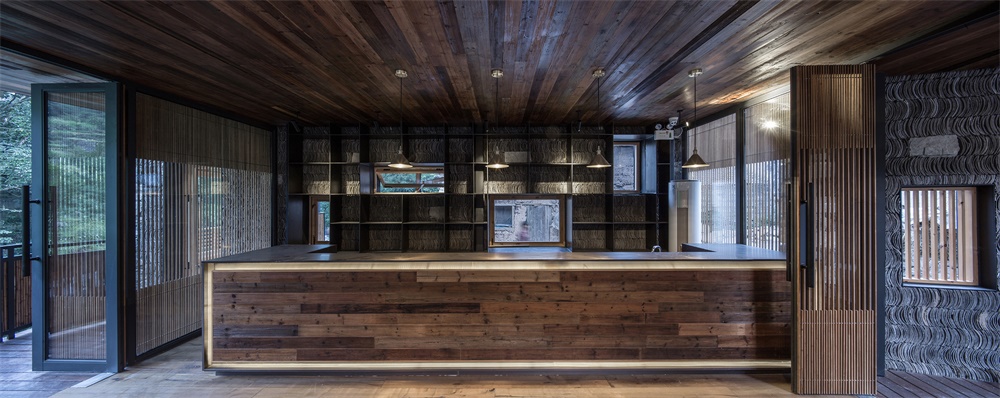
∇ 從休閑水吧室內看到小溪對岸的古樹Old trees across the stream from the water bar ©趙奕龍
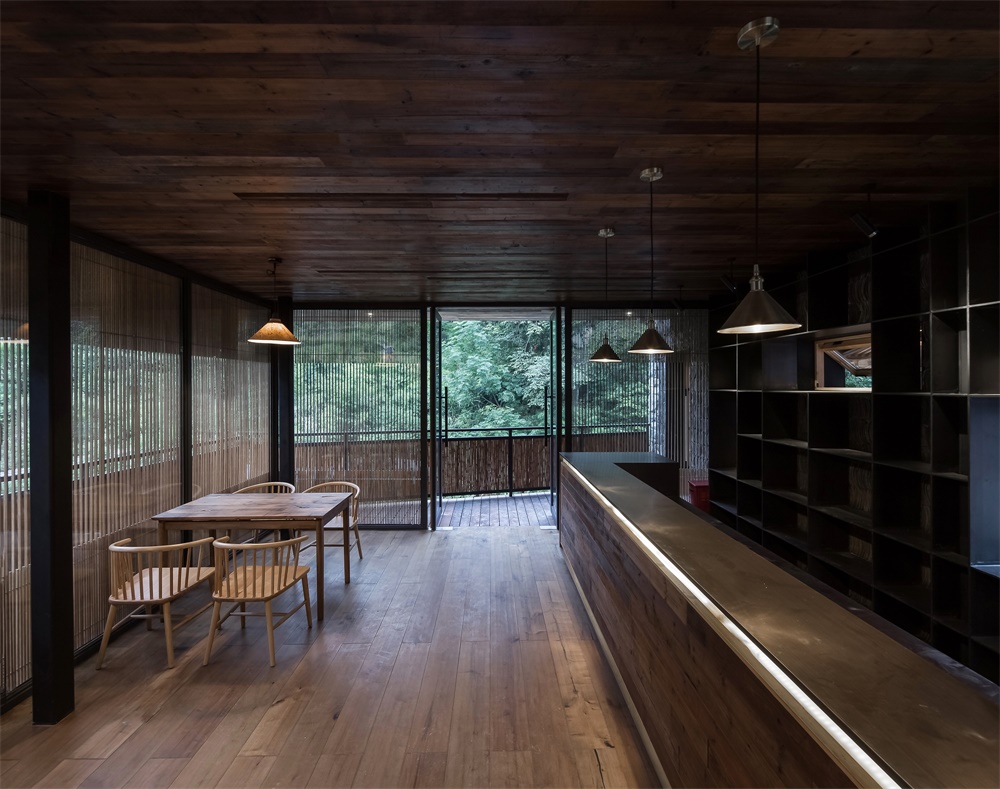
∇ 立麵格柵倒影在水麵上Grid reflection on water ©趙奕龍
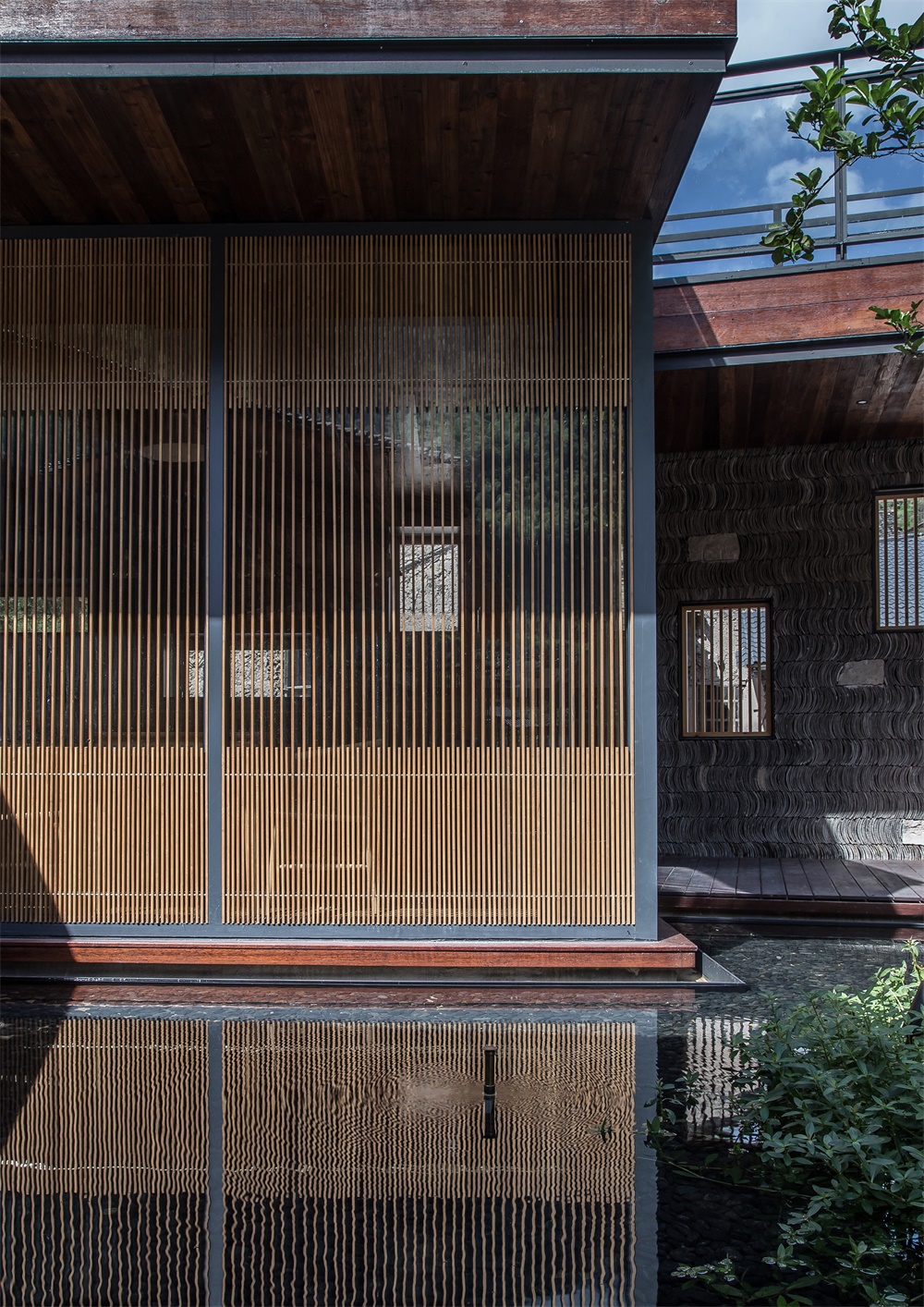
∇ 霧天平台上看出去的場景Scenes on the platform in fog ©趙奕龍
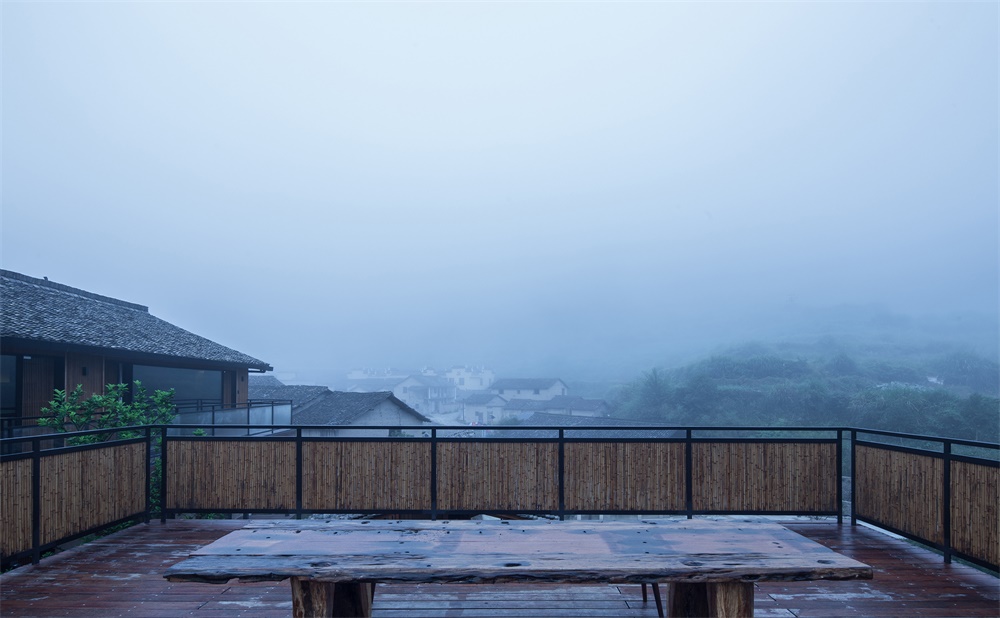
∇ 一層客房看向庭院場景First floor of the residence towards the courtyard ©趙奕龍
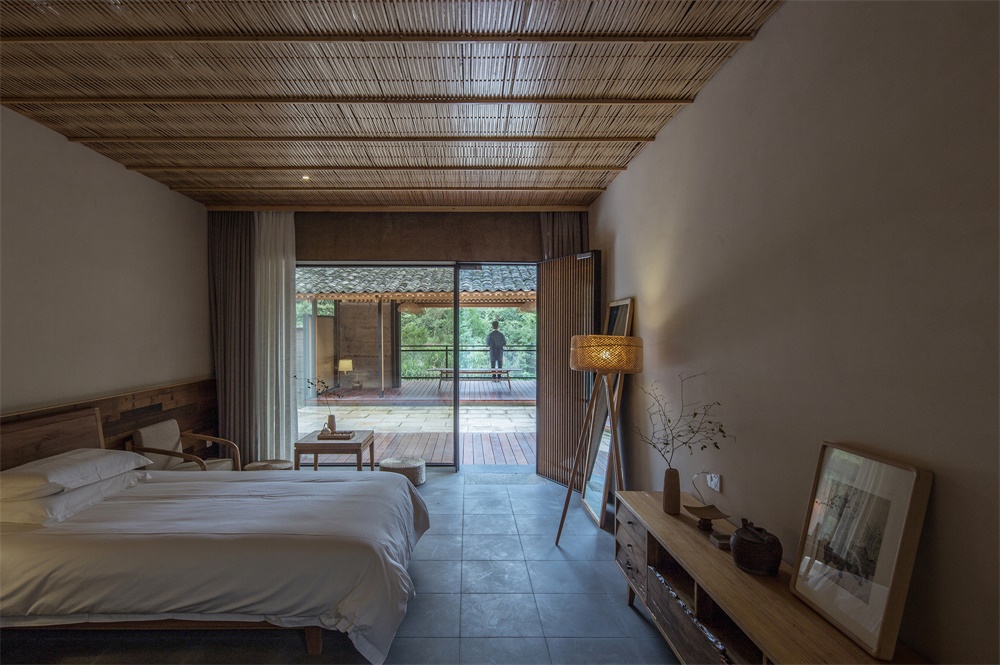
∇ 一層客房室內場景Interior scene of first floor of the residence ©趙奕龍
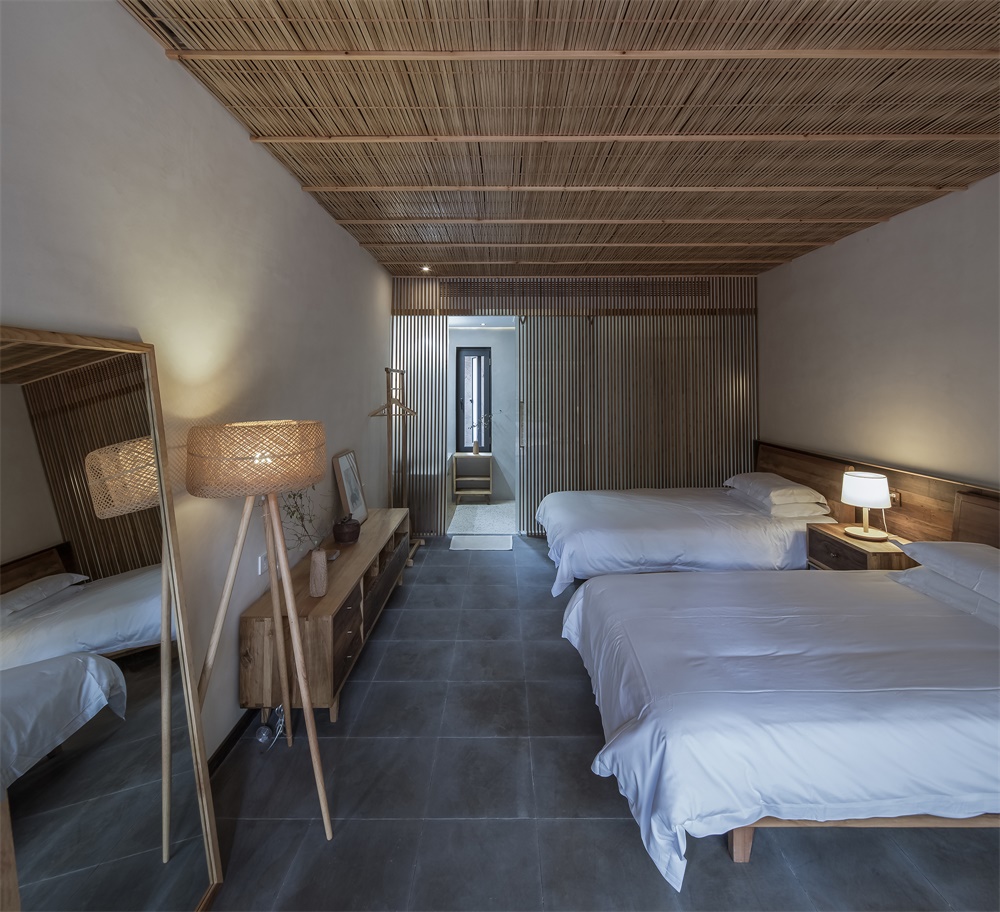
∇ 二層客房的橫向大觀景麵Horizontal view of the second floor of the residence ©趙奕龍
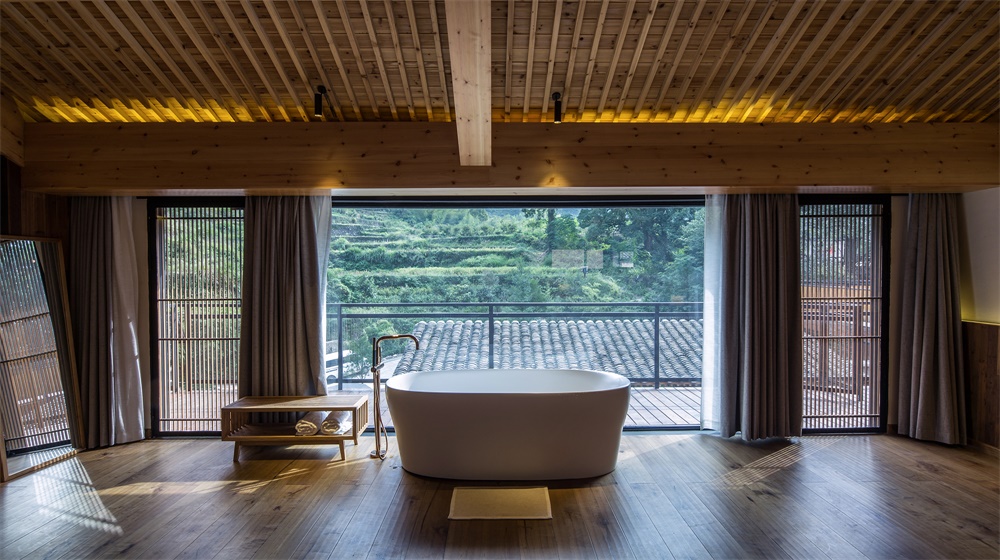
∇ 二層客房室內場景Interior scene of the second floor of the residence ©趙奕龍
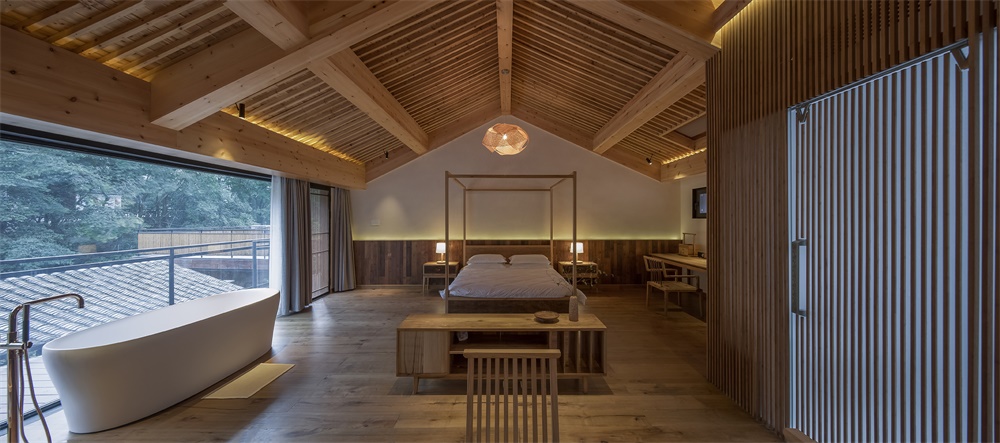
風穿過院子,微氣候循環
Microclimate cycle brought by the wind
夏天的一個中午,外麵的溫度很高,在其他的房子裏也感覺特別熱,我從村子裏走入民宿,體感溫度一下子就降了下來,廊子裏,能感覺到對流的風從中穿過,即使站在有太陽的院子裏也感覺不到熱,室內就更加的涼爽了。在建築設計之初就考慮了其通風采光、保溫隔熱各方麵的性能,建築的體量上沿著地形關係呈階梯狀,在外圍牆體上開了很多通風和視線穿透的小窗洞,空氣順著這樣的空間形態產生自然風的流動,同時建築材料也緩解熱量吸收,再加上旁邊小溪的水麵和古樹綠蔭更加強了建築的微氣候循環。
At noon in summer, when the temperature outside is very high, and it feels particularly hot in other houses, I walked into the residence and felt a sudden drop in the temperature. In the corridor, wind funnels through, even in a yard under the sunshine, it won’t be too warm. The inside is even cooler. The original architectural design takes into consideration the ventilation and lighting, heat insulation and other aspects of performance. The volume of the building forms a step with the site, and many small holes for ventilation and view were opened on the peripheral wall. The air flow in this space creates a feeling of natural wind, and the building materials also absorb heat. In addition, the water surface of the nearby creek and the shade of ancient trees strengthen the microclimate cycle of the building.
∇ 自然通風分析圖 Analysis of natural ventilation ©尌林建築
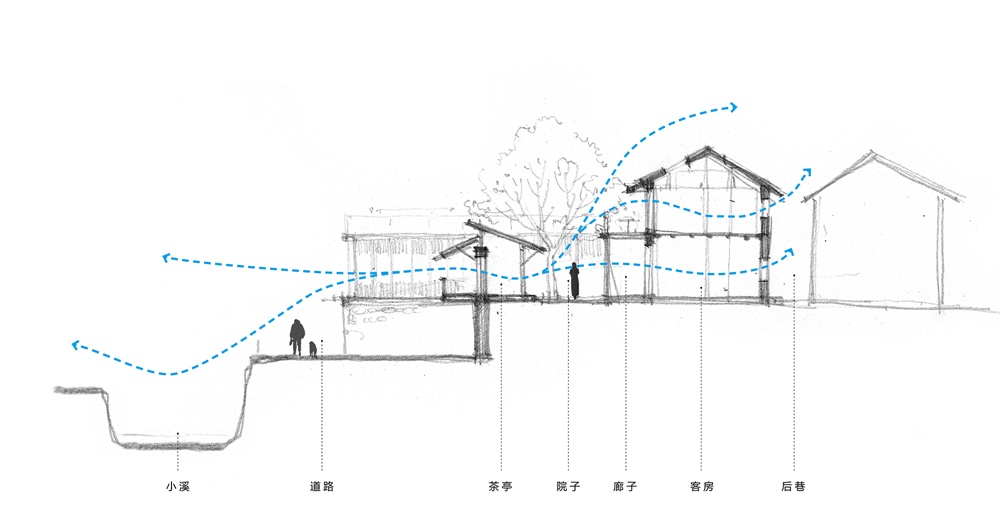
∇ 貫穿廊道·水庭院·觀山亭·山景的空間場景Space scenes: corridors, water courtyards, mountain pavilions and mountain views ©趙奕龍
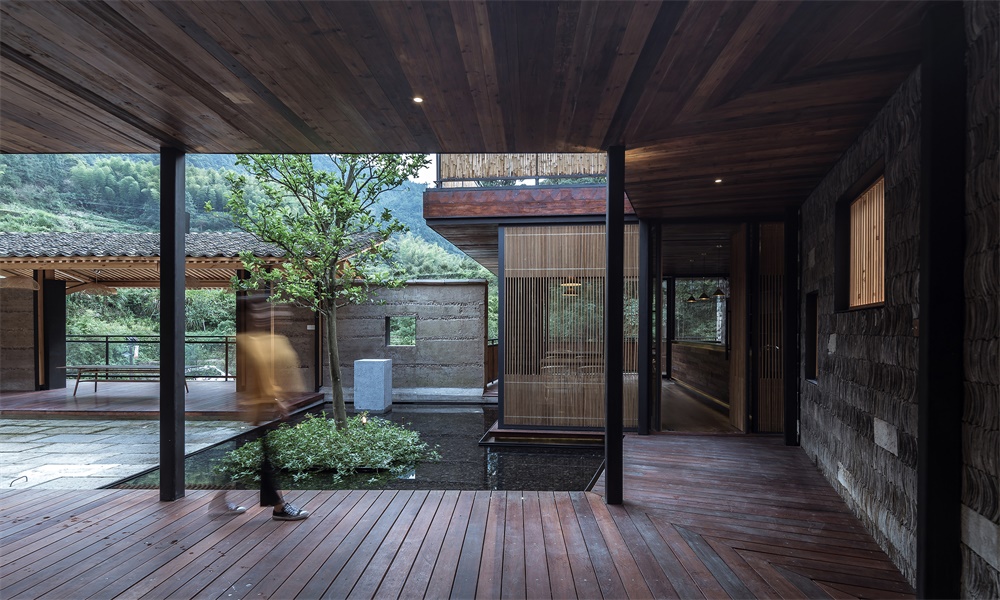
∇ 貫穿庭院·觀山亭·道路·小溪的空間場景Space scenes: the courtyard, the mountain pavilion, the path and the stream ©趙奕龍
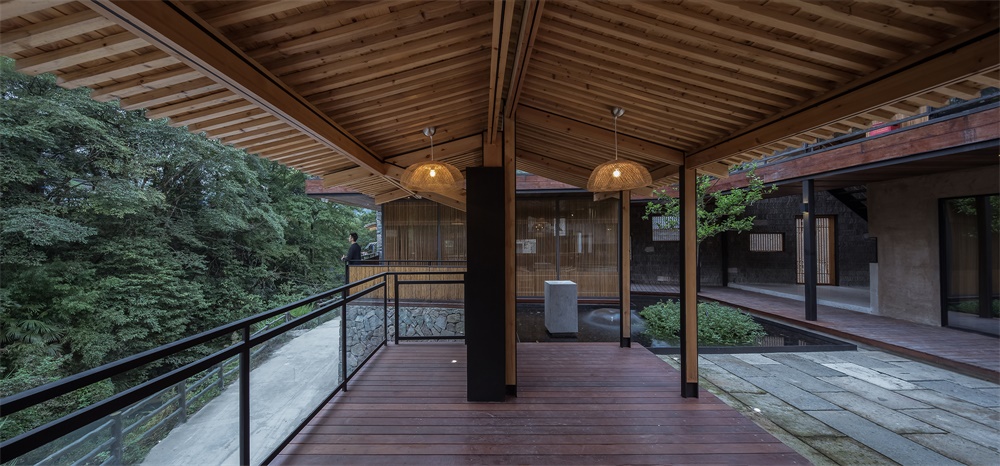
∇ 樓梯處廊道·屋頂·瓦牆的空間關係Spatial relationship of corridors, roofs, and tile walls at stairs ©趙奕龍
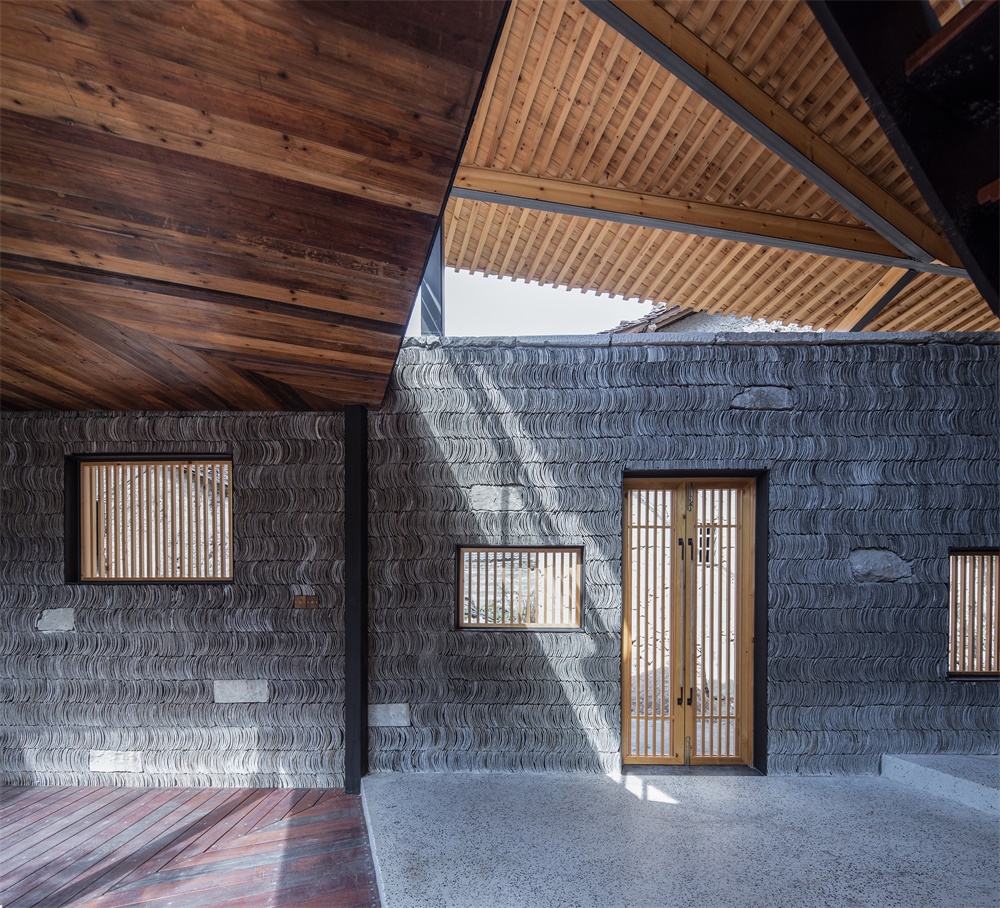
建築將公共性還給村民
Return the space to villagers
場地上原來有一個小的公廁,是屬於村民集體使用的公共空間,在建造民宿的時候希望把這部分公共空間再還給村民。位置在巷道的端頭,旁邊是古樹和小溪,我們把這個位置做成了一個半開放的亭子,對著村裏的古樹和小溪,村民們閑來無事的時候可以坐在這邊閑聊。亭子還有另外一個功能,傍晚亭子的燈光亮起來,便像是一盞燈籠,為村民們照亮回家的路。
There was originally a small public toilet, which was a public space collectively used by the villagers. When constructing the residence, I hope to give back this part of the public space to them. The location is at the end of the roadway, next to the old trees and the stream. Therefore, we used a semi-open pavilion facing the trees and the stream so that villagers can spend time chatting here. The pavilion also functions as a lighthouse to show the villagers their way home in the evening.
∇ 亭子牆身詳圖Details of the pavilion wall ©尌林建築

∇ 西側鋼木結構亭子Steel and wood structure of the pavilion on the west ©趙奕龍
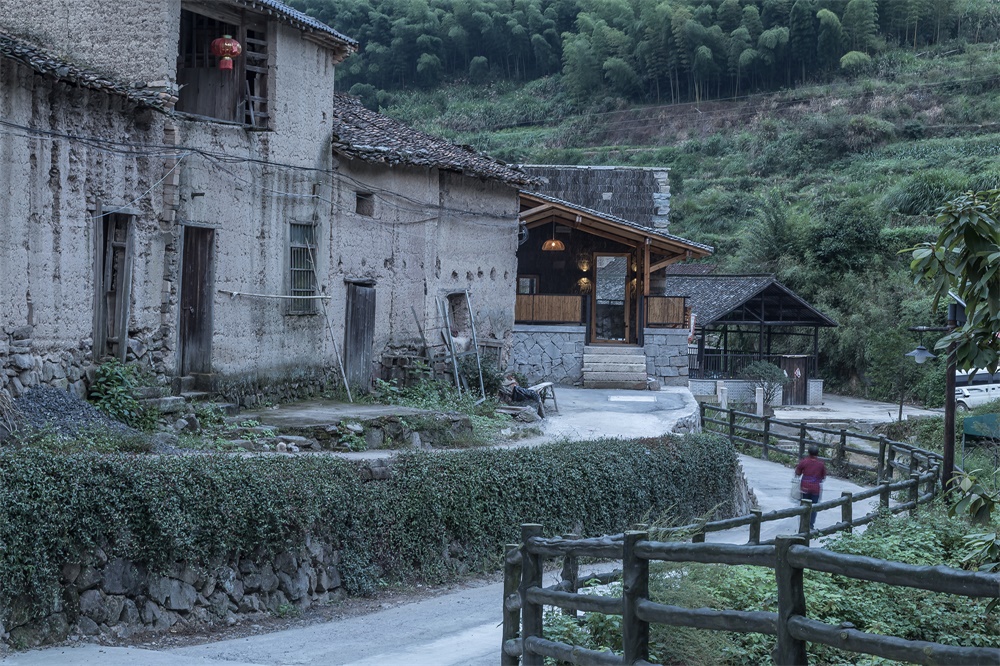
∇ 村民在亭子裏喝茶Villagers drinking tea in the pavilion ©趙奕龍
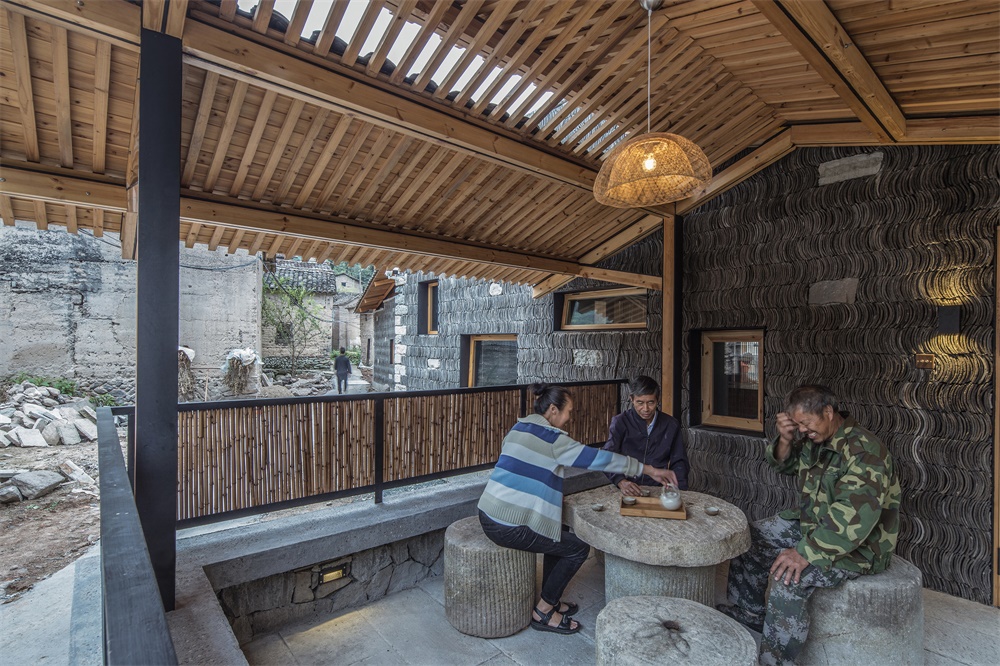
∇ 村民坐在亭子裏聽溪觀樹Villagers sitting in the pavilion listening to the stream and watching the trees ©趙奕龍
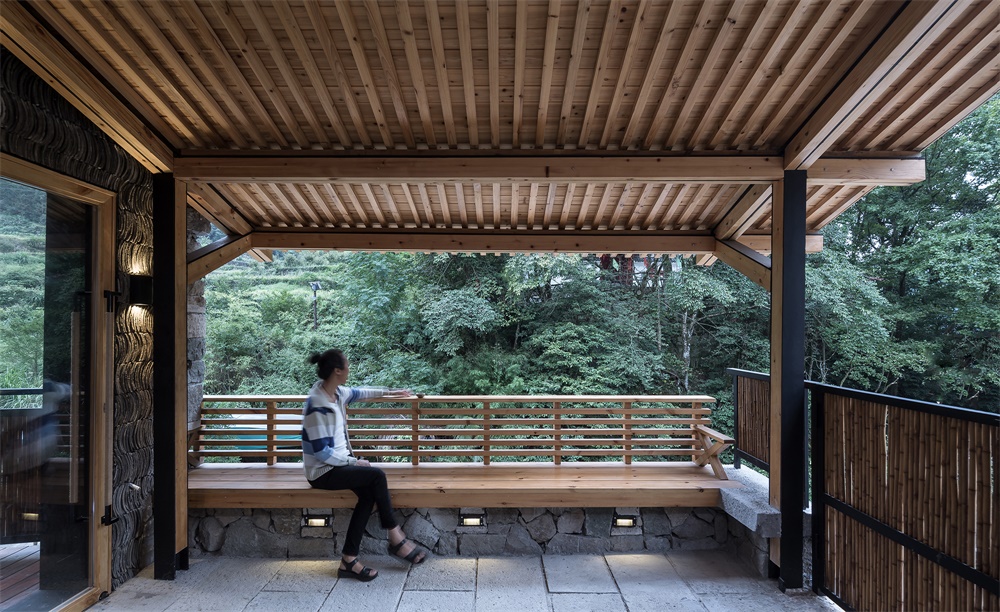
∇ 傍晚亮燈的亭子Pavilion lit up in the evening ©趙奕龍
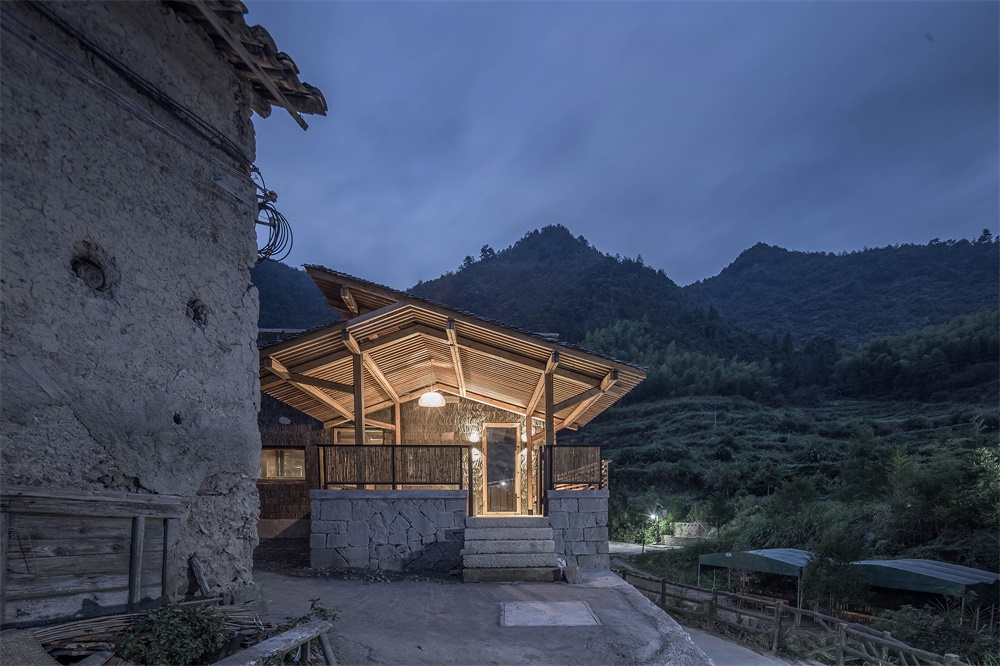
模糊邊界產生的矛盾
Paradoxical boundaries
建築處於古村中,建築周邊場地歸屬權比較複雜,在設計之前也沒法給到非常確定的邊界,我們就按照之前原建築拆除之前的建築邊界來定的範圍,但是在建造的過程就不斷的遇到問題,給建築落地帶來很多的困擾,這是在設計之前沒有想到的。首先是鄰居不願共用通道,套房獨立樓梯超出邊界取消,入口超界退進,而後村裏道路寬度保證通車便利建築台基退讓等各種領地歸屬邊界退讓的問題,當然也正是鄉村營造所獨有的特殊性,也因為有這些因素和邊界,鄉村項目變得有趣和生動,有更多的社會性存在,在這個過程中讓我們學會了很多應對這類問題的策略和方法,為今後的項目實踐積累經驗。
Located among the old trees, the architecture has a relatively complicated situation in terms of its ownership. Before the design, it is also too difficult to give a specific boundary, which had led to repetitive problems during the construction. Many unexpected troubles occur: the villagers fused to share the path, therefore, we had to abort the plan that each suite would have an independent stair that is beyond the boundary and moved the entrance back; boundary issues also came up when deciding the base for the platform, as the width of the road needed to suit vehicles. Surely, these problems are also unique ones in a construction within an old village, which guarantees its unique feature and gives life and fun to the project. During this process, we learnt many strategies and solutions to issues like these, and have accumulated experience for later practice.
∇ 霧天對麵田埂上看民宿Residence from the opposite ridge in the fog ©趙奕龍
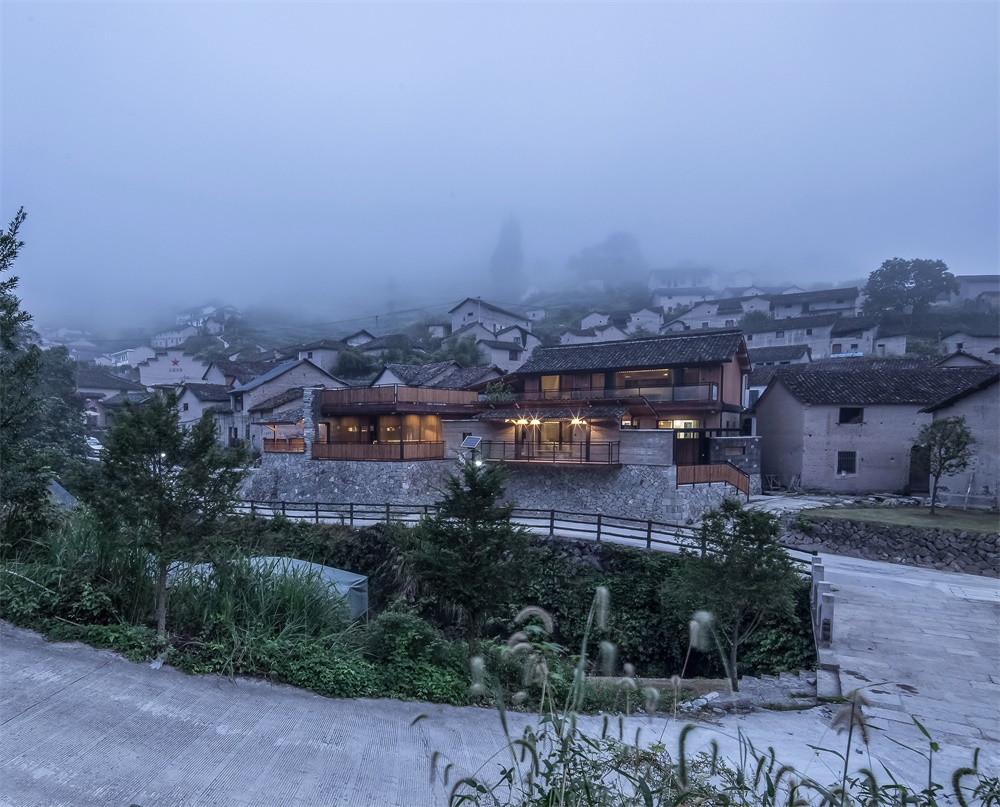
∇ 建築與村道的階梯關係Stairs between building and path ©趙奕龍
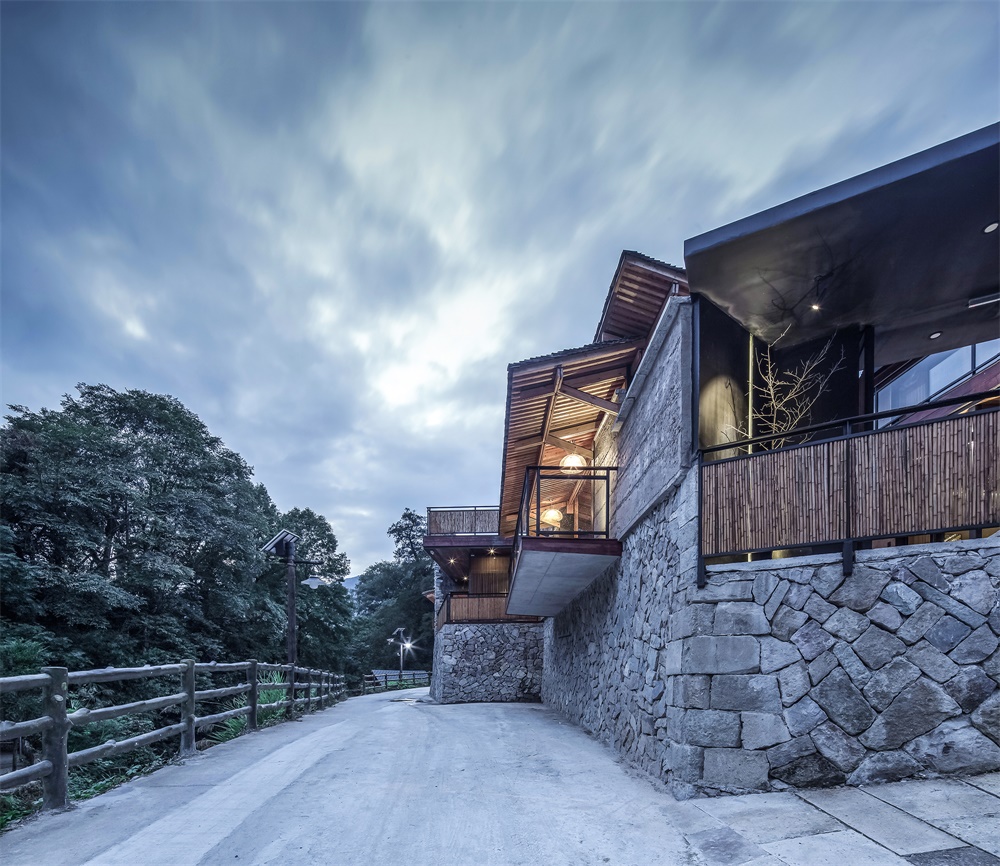
∇ 手繪民宿全景Hand-drawn residences panorama ©尌林建築
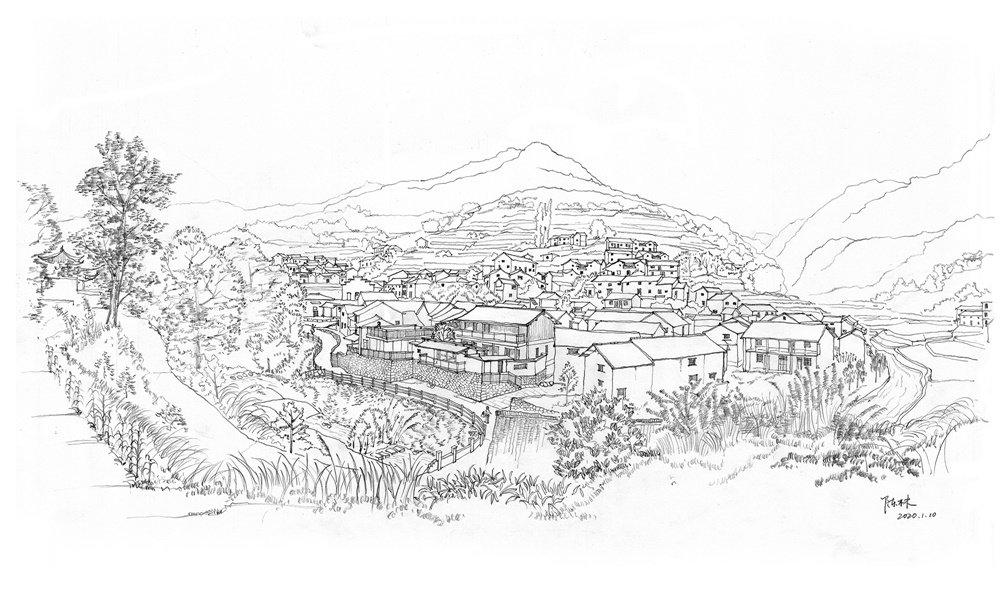
∇ 結構分解示意Structural decomposition ©尌林建築
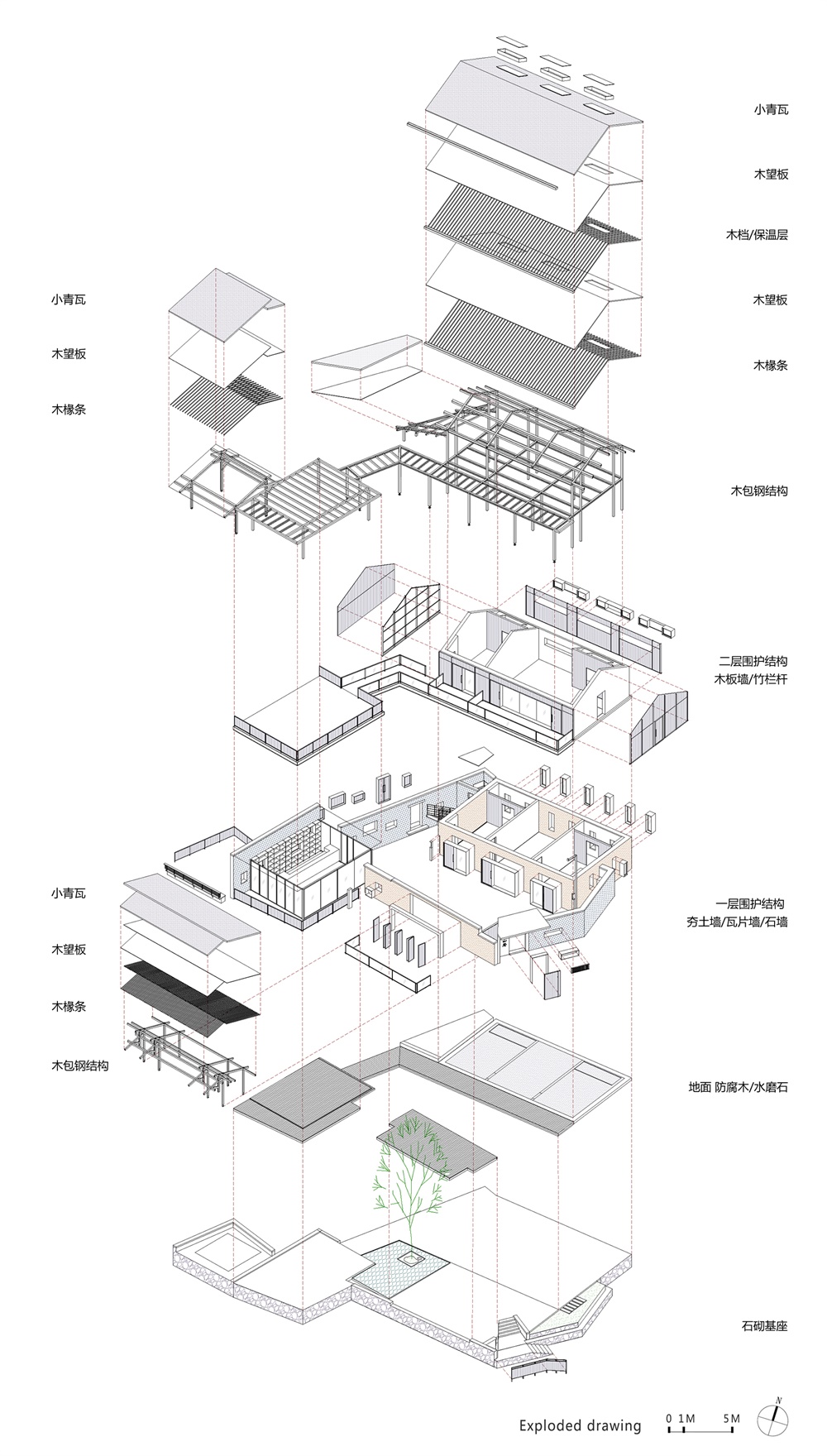
∇ 走廊牆身詳圖Details of the corridor wall ©尌林建築
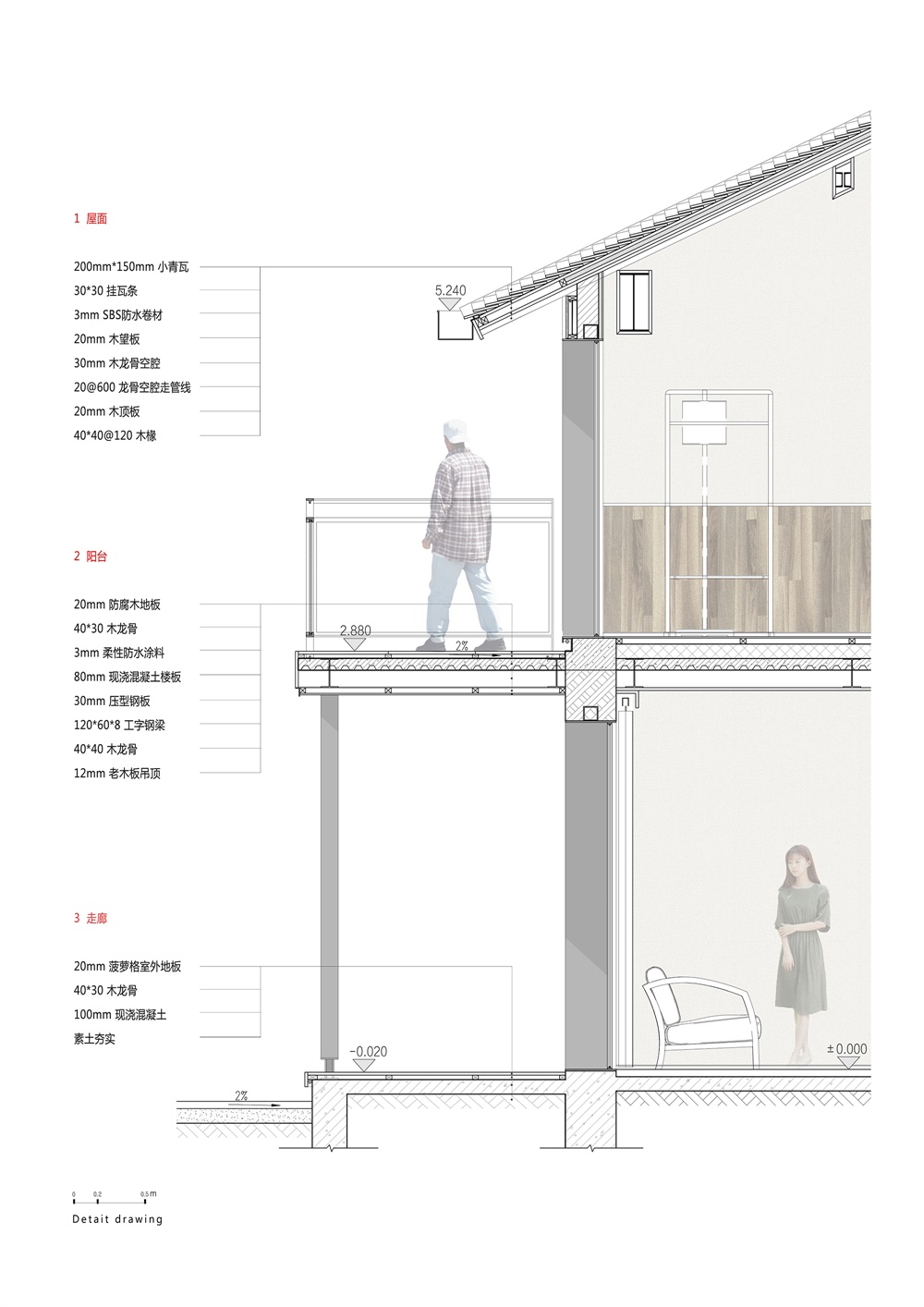
∇ 外牆牆身詳圖Details of the exterior wall ©尌林建築
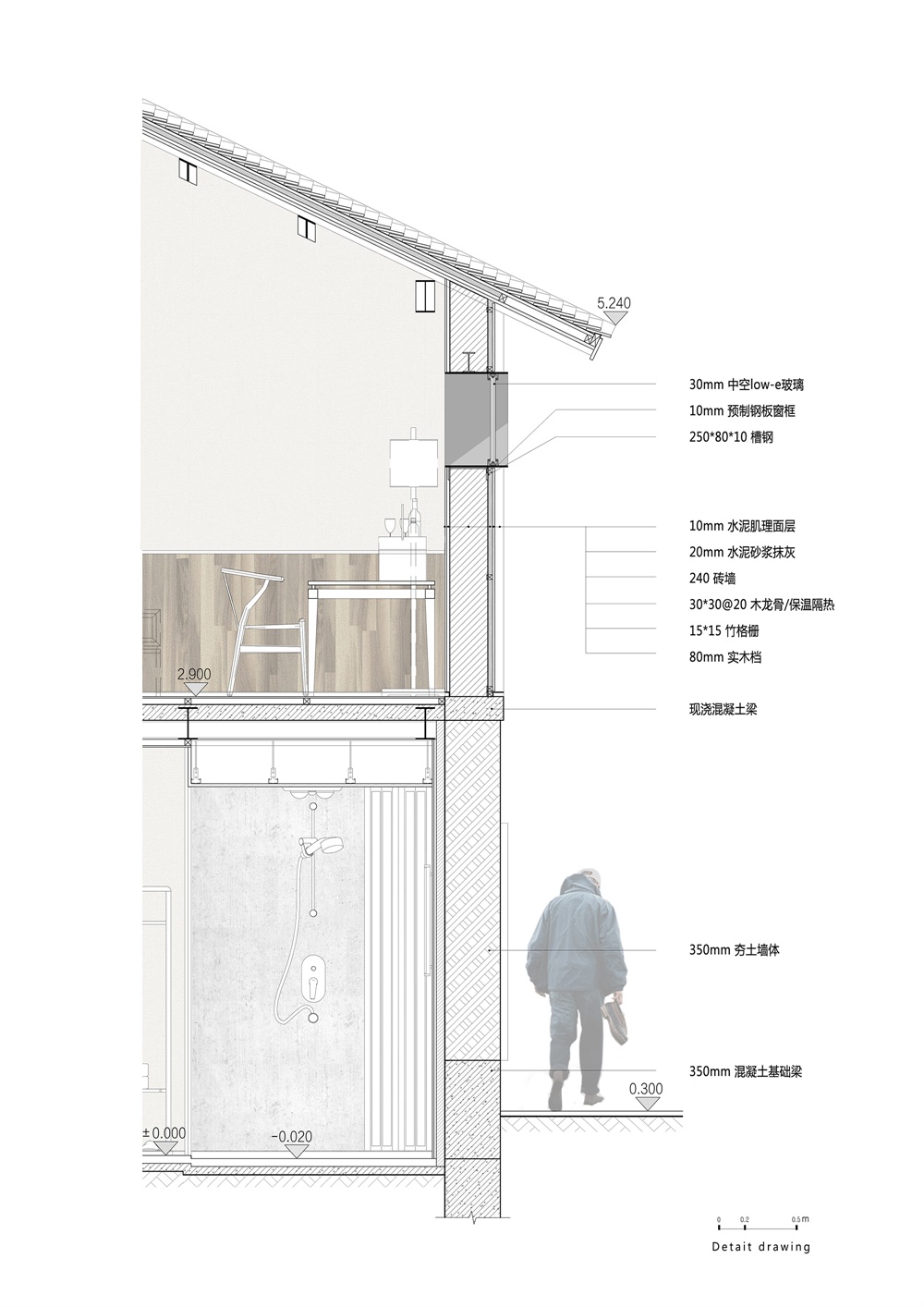
完整項目信息
項目名稱:武義梁家山·清嘯山居·民宿
設計單位:尌林建築設計事務所
公司網站:www.hzshulin.com
聯係郵箱:252404031@qq.com
主持建築師:陳林
設計團隊:劉東英、時偉權、陳伊妮
結構形式:鋼木結構
項目類型:鄉村民宿
設計時間:2016.10-2017.9
建造時間:2017.9-2019.5
項目地點:金華武義柳城鎮梁家山村
項目業主:宏福旅遊集團有限公司
建築材料:夯土、小青瓦、竹、老石板、水磨石、毛石
建築麵積:320㎡
工程造價:250萬
建築攝影:趙奕龍
Project Information:
Project Name: Wuyi Liangjiashan · Qingxiao Residence
Designed by: Shulin Architectural Design
Company website: www.hzshulin.com
Contact Email: 252404031@qq.com
Architect in Charge: Chen Lin
Design Team: Liu Dongying, Shi Weiquan, Chen Yini
Structural form: Steel-wood
Project Type: Country House
Design time: 2016.10-2017.9
Construction time: 2017.9-2019.5
Project location: Liangjiashan Village, Wuyiliu Town, Jinhua
Project Owner: Hongfu Tourism Group Company.
Building materials: Rammed earth, small green tiles, bamboo, old slate, terrazzo, rubbles
Building area: 320㎡
Construction cost: 2.5 million
Architectural Photography: Zhao Yilong


